Mapping Urbanization and Evaluating Its Possible Impacts on Stream Water Quality in Chattanooga, Tennessee, Using GIS and Remote Sensing
Abstract
1. Introduction
1.1. Urbanization and Surface Water Quality
1.2. Land Use and Land Cover Change (LULC) and Urbanization
1.3. Urban Growth and Riparian Areas
1.4. Mapping Urban Growth
1.5. Analysis Techniques
1.6. Statement of the Problem and Scope of the Study
2. Materials and Methods
2.1. Study Site
2.2. Data Collection and Processing
2.3. Mapping Impervious Surfaces
2.4. Normalized Difference Vegetation Index (NDVI)
2.5. Image Classification
2.6. Data Integration
2.7. Accuracy Assessment
2.7.1. Zonal Statistics
2.7.2. Kappa Statistics
2.8. Water Resource Proximity Analysis
2.9. Assessing Stream Risk
2.9.1. Stream Segmentation
2.9.2. Riparian Zone Generation
2.9.3. Relating IS Development Proximity and Quantity to Risk
3. Results and Analysis
3.1. Impervious Surface (IS) Mapping
3.2. Water Resource Proximity Analysis
3.3. Riparian Development and Risk Analysis
3.3.1. Riparian Percent Imperviousness
3.3.2. Stream Risk Assessment
4. Discussions
4.1. Impervious Surface (IS) Mapping
4.2. Impervious Surface (IS) Classification Accuracy
4.3. Water Resource Proximity to Impervious Surfaces
4.4. Impairment Risk Due to IS Development
4.5. Limitations and Challenges
5. Conclusions
Author Contributions
Funding
Acknowledgments
Conflicts of Interest
Appendix A
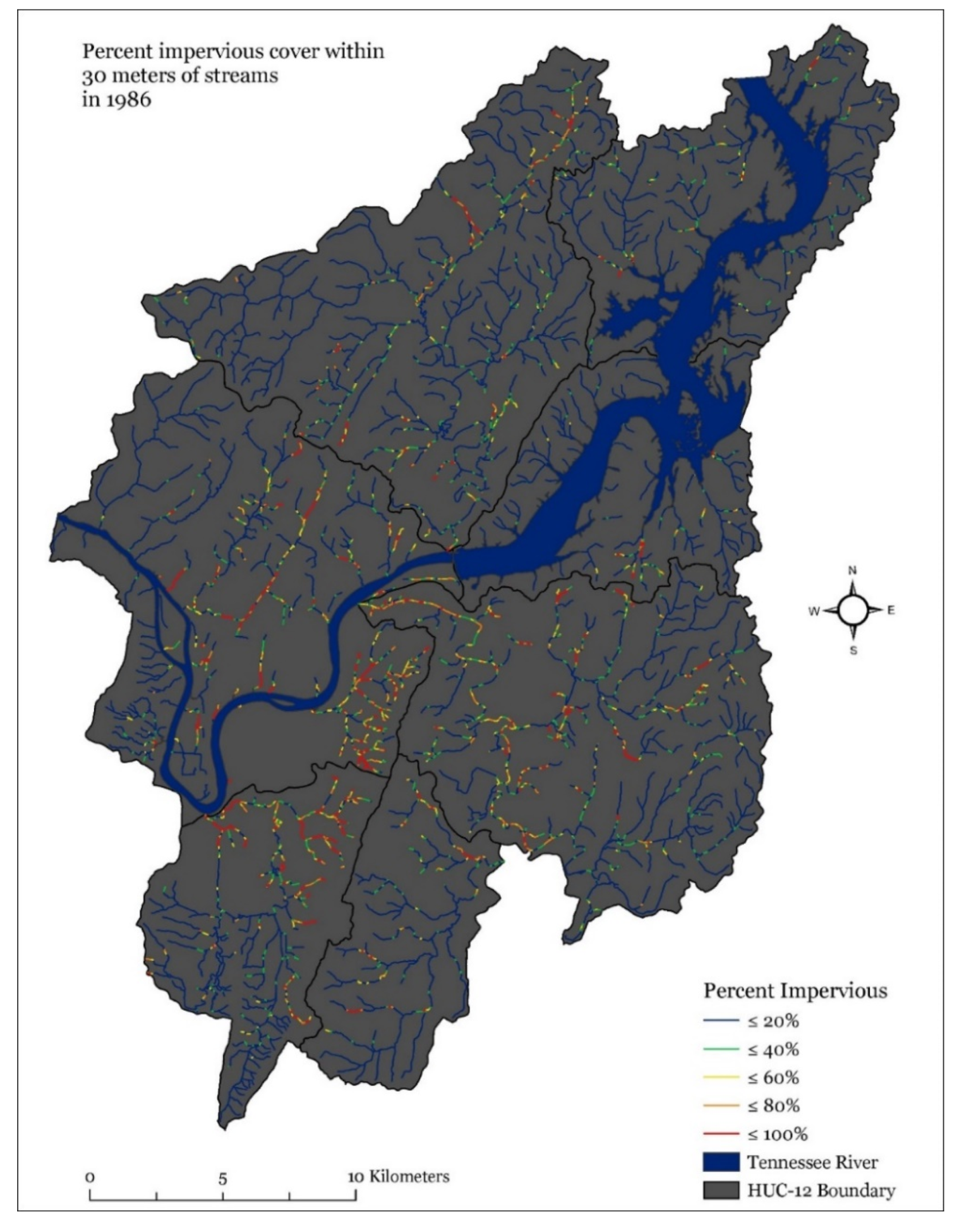
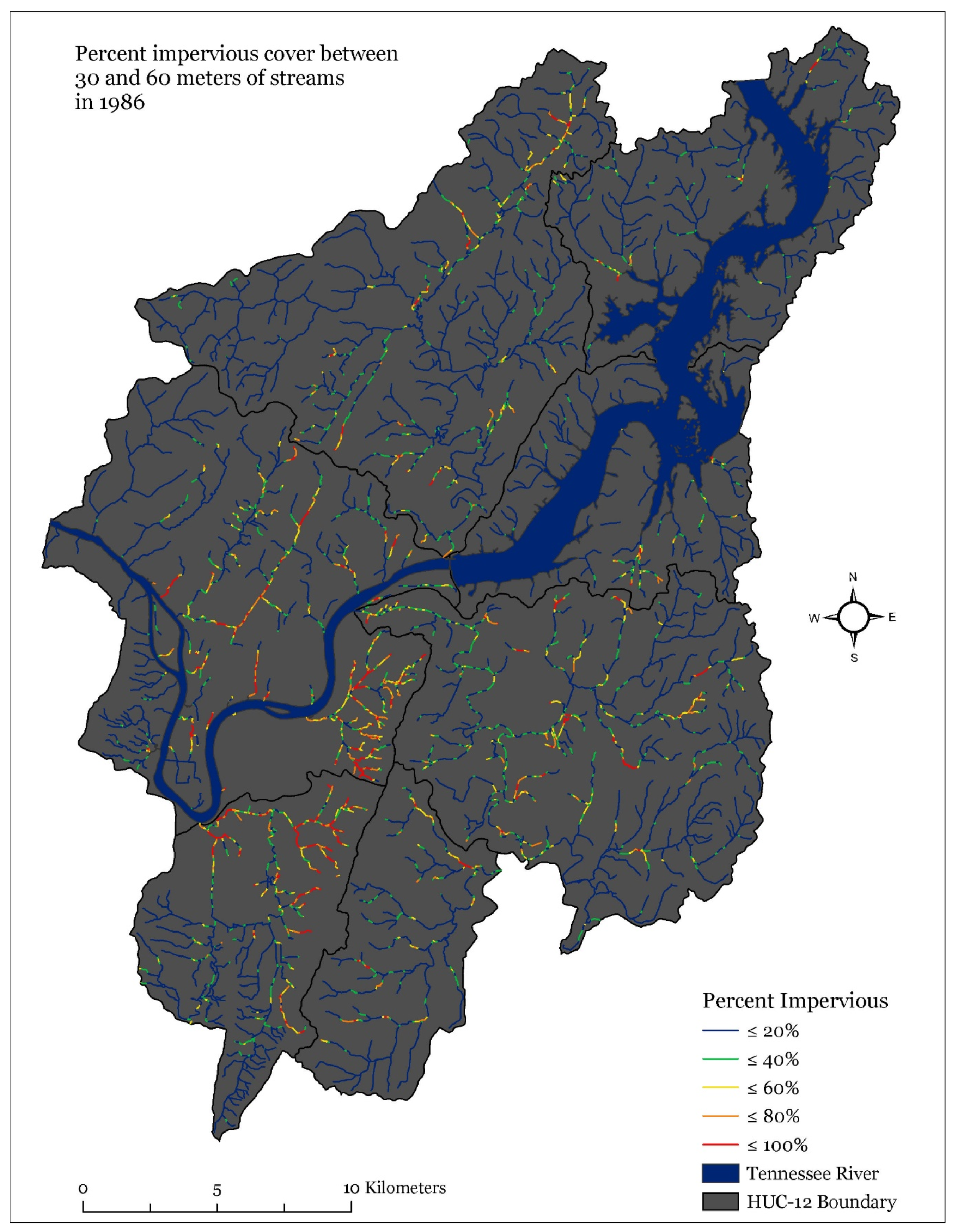

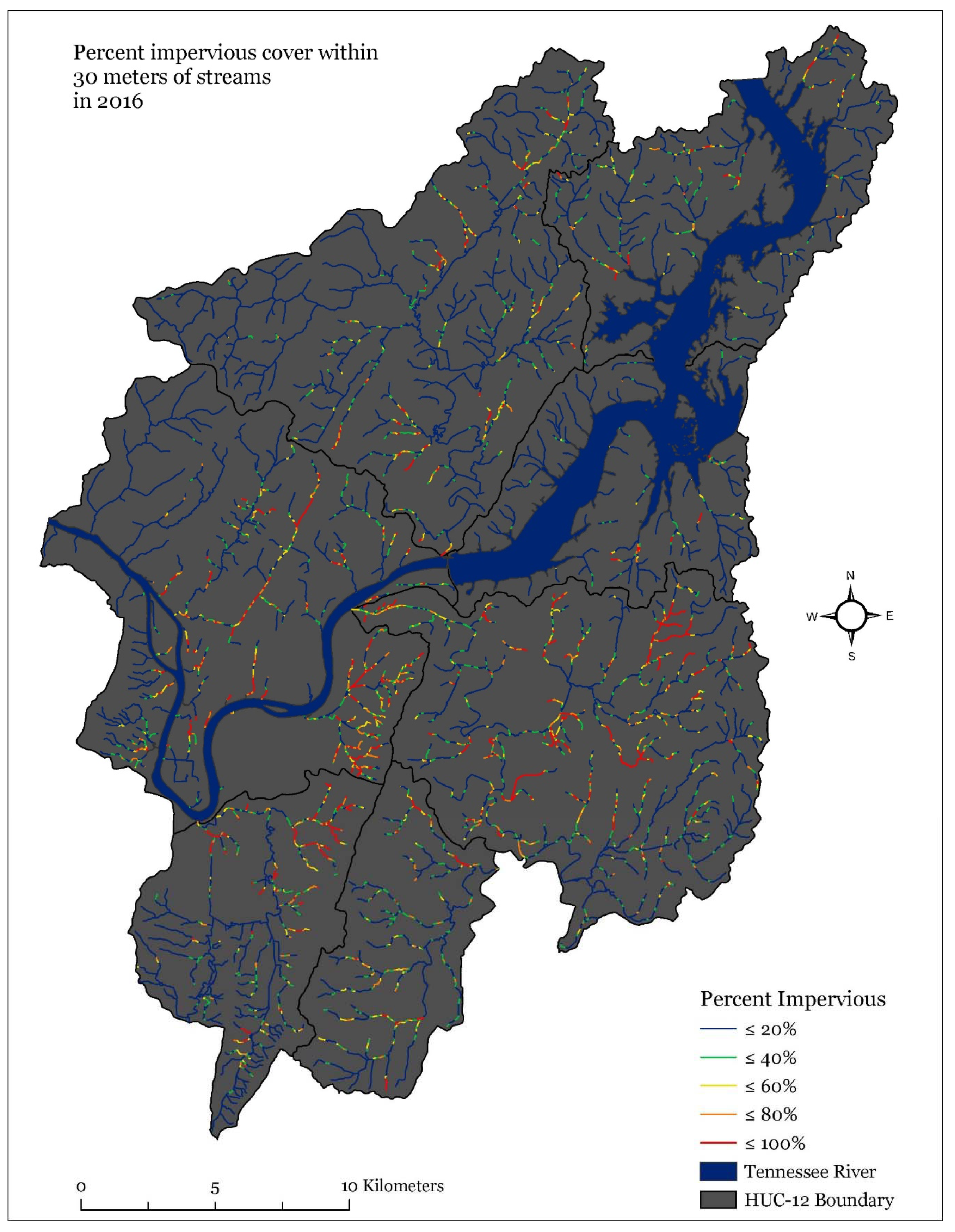
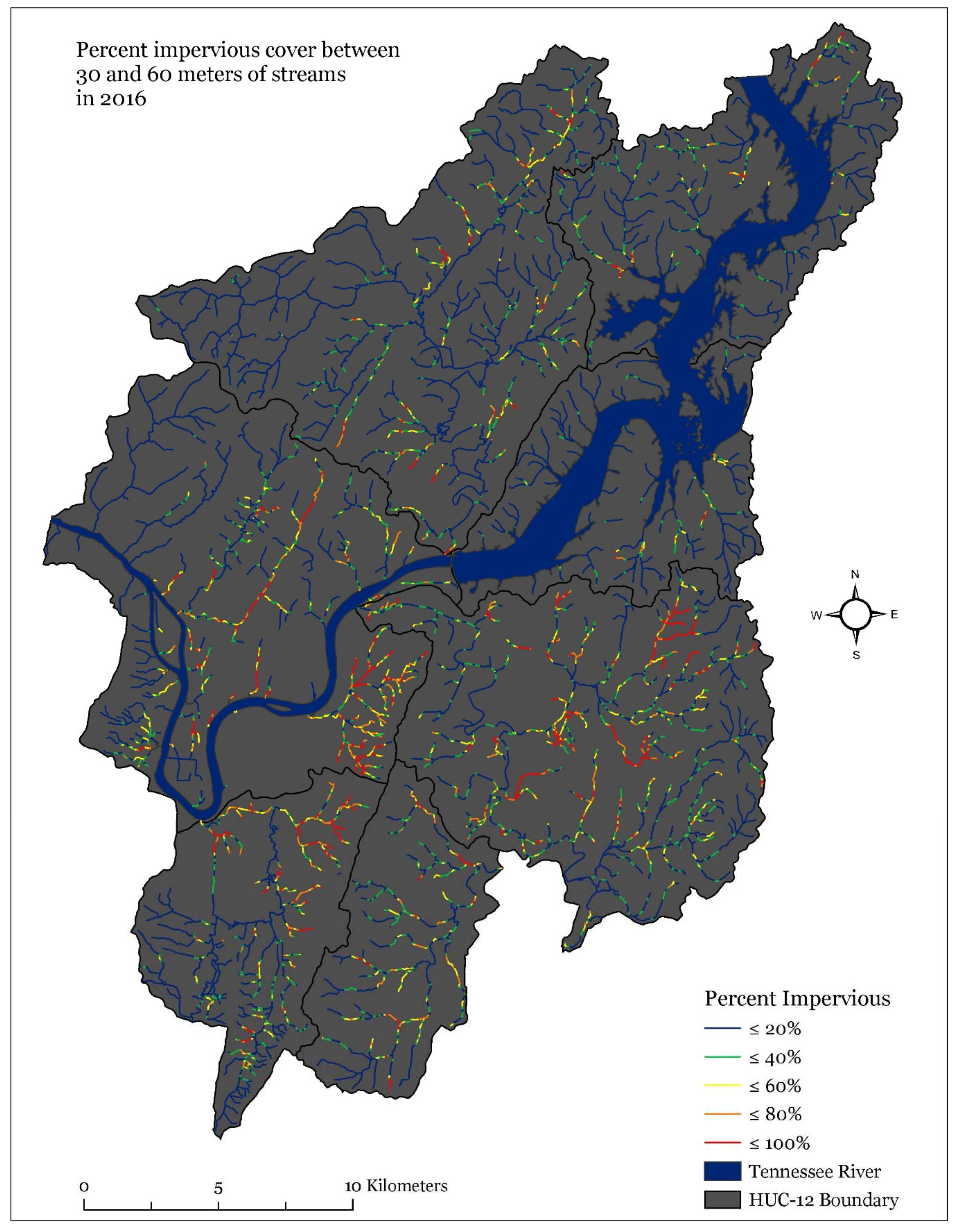

References
- Chithra, S.; Nair, M.H.; Amarnath, A.; Anjana, N. Impacts of impervious surfaces on the environment. Int. J. Eng. Sci. Invent. 2015, 4, 2319–6726. [Google Scholar]
- Barnes, K.B.; Morgan, J.; Roberge, M. Impervious surfaces and the quality of natural and built environments. In Department of Geography and Environmental Planning; Towson University: Baltimore, MD, USA, 2001. [Google Scholar]
- United Nations Department of Economic and Social Affairs, P.D. World Urbanization Prospects: The 2014 Revision; ST/ESA/SER.A/366. 2015. Available online: https://www.un.org/en/development/desa/publications/2014-revision-world-urbanization-prospects.html (accessed on 28 February 2020).
- Madlener, R.; Sunak, Y. Impacts of urbanization on urban structures and energy demand: What can we learn for urban energy planning and urbanization management? Sustain. Cities Soc. 2011, 1, 45–53. [Google Scholar] [CrossRef]
- Li, B.Z.; Yao, R.M. Urbanization and its impact on building energy consumption and efficiency in China. Renew. Energy 2009, 34, 1994–1998. [Google Scholar] [CrossRef]
- Li, K.; Lin, B.Q. Impacts of urbanization and industrialization on energy consumption/CO2 emissions: Does the level of development matter? Renew. Sustain. Energy Rev. 2015, 52, 1107–1122. [Google Scholar] [CrossRef]
- Liddle, B. Impact of population, age structure, and urbanization on carbon emissions/energy consumption: Evidence from macro-level, cross-country analyses. Popul. Environ. 2014, 35, 286–304. [Google Scholar] [CrossRef]
- Satterthwaite, D.; McGranahan, G.; Tacoli, C. Urbanization and its implications for food and farming. Philos. Trans. R. Soc. B Biol. Sci. 2010, 365, 2809–2820. [Google Scholar] [CrossRef] [PubMed]
- Nizeyimana, E.L.; Petersen, G.W.; Imhoff, M.L.; Sinclair, H.R.; Waltman, S.W.; Reed-Margetan, D.S.; Levine, E.R.; Russo, J.M. Assessing the impact of land conversion to urban use on soils with different productivity levels in the USA. Soil Sci. Soc. Am. J. 2001, 65, 391–402. [Google Scholar] [CrossRef]
- Szabo, S. Urbanization and food insecurity risks: Assessing the role of human development. Oxf. Dev. Stud. 2016, 44, 28–48. [Google Scholar] [CrossRef]
- Huang, S.L.; Yeh, C.T.; Chang, L.F. The transition to an urbanizing world and the demand for natural resources. Curr. Opin. Environ. Sustain. 2010, 2, 136–143. [Google Scholar] [CrossRef]
- Barlow, S.A.; Munn, I.A.; Cleaves, D.A.; Evans, D.L. The effect of urban sprawl on timber. J. For. 1998, 96, 10–14. [Google Scholar]
- Munn, I.A.; Barlow, S.A.; Evans, D.L.; Cleaves, D. Urbanization's impact on timber harvesting in the south central United States. J. Environ. Manag. 2002, 64, 65–76. [Google Scholar] [CrossRef]
- Nowak, D.J.; Walton, J.T. Projected urban growth (2000–2050) and its estimated impact on the US forest resource. J. For. 2005, 103, 383–389. [Google Scholar]
- Putro, B.; Kjeldsen, T.R.; Hutchins, M.G.; Miller, J. An empirical investigation of climate and land-use effects on water quantity and quality in two urbanizing catchments in the southern United Kingdom. Sci. Total Environ. 2016, 548, 164–172. [Google Scholar] [CrossRef] [PubMed]
- Zipper, S.C.; Soylu, M.E.; Kucharik, C.J.; Loheide, S.P. Quantifying indirect groundwater-mediated effects of urbanization on agroecosystem productivity using modflow-agroibis (MAGI), a complete critical zone model. Ecol. Model. 2017, 359, 201–219. [Google Scholar] [CrossRef]
- Black, D.; Black, J. A review of the urban development and transport impacts on public health with particular reference to Australia: Trans-disciplinary research teams and some research gaps. Int. J. Environ. Res. Public Health 2009, 6, 1557–1596. [Google Scholar] [CrossRef] [PubMed]
- Liu, Z.H.; Wang, Y.L.; Li, Z.G.; Peng, J. Impervious surface impact on water quality in the process of rapid urbanization in Shenzhen, China. Environ. Earth Sci. 2013, 68, 2365–2373. [Google Scholar] [CrossRef]
- Xian, G.; Crane, M. Assessments of urban growth in the Tampa Bay watershed using remote sensing data. Remote Sens. Environ. 2005, 97, 203–215. [Google Scholar] [CrossRef]
- Tu, J.; Xia, Z.G.; Clarke, K.C.; Frei, A. Impact of urban sprawl on water quality in eastern Massachusetts, USA. Environ. Manag. 2007, 40, 183–200. [Google Scholar] [CrossRef]
- Arnold, C.L., Jr.; Gibbons, C.J. Impervious surface coverage: The emergence of a key environmental indicator. J. Am. Plan. Assoc. 1996, 62, 243–258. [Google Scholar] [CrossRef]
- Du, N.; Ottens, H.; Sliuzas, R. Spatial impact of urban expansion on surface water bodies—A case study of Wuhan, China. Landsc. Urban Plan. 2010, 94, 175–185. [Google Scholar] [CrossRef]
- Todd, D.A.; Bedient, P.B.; Haasbeek, J.F.; Noell, J. Impact of land-use and NPS loads on lake quality. J. Environ. Eng. ASCE 1989, 115, 633–649. [Google Scholar] [CrossRef]
- Carle, M.V.; Halpin, P.N.; Stow, C.A. Patterns of watershed urbanization and impacts on water quality. J. Am. Water Resour. Assoc. 2005, 41, 693–708. [Google Scholar] [CrossRef]
- Price, K.; Leigh, D.S. Comparative water quality of lightly-and moderately-impacted streams in the southern Blue Ridge Mountains, USA. Environ. Monit. Assess. 2006, 120, 269–300. [Google Scholar] [CrossRef] [PubMed]
- Brett, M.T.; Arhonditsis, G.B.; Mueller, S.E.; Hartley, D.M.; Frodge, J.D.; Funke, D.E. Non-point-source impacts on stream nutrient concentrations along a forest to urban gradient. Environ. Manag. 2005, 35, 330–342. [Google Scholar] [CrossRef]
- Teixeira, L.C.; de Paiva, J.B.D.; Pereira, J.E.D.; Lisboa, R.D. Relationship between turbidity and suspended sediment concentration from a small hydrographic basin in Santa Maria (Rio Grande do Sul, Brazil). Int. J. River Basin Manag. 2016, 14, 393–399. [Google Scholar] [CrossRef]
- Tu, J. Spatially varying relationships between land use and water quality across an urbanization gradient explored by geographically weighted regression. Appl. Geogr. 2011, 31, 376–392. [Google Scholar] [CrossRef]
- Tong, S.T.Y.; Chen, W.L. Modeling the relationship between land use and surface water quality. J. Environ. Manag. 2002, 66, 377–393. [Google Scholar] [CrossRef]
- Tu, J. Spatial variations in the relationships between land use and water quality across an urbanization gradient in the watersheds of Northern Georgia, USA. Environ. Manag. 2013, 51, 1–17. [Google Scholar] [CrossRef]
- May, C.W.; Horner, R.R.; Karr, J.R.; Mar, B.W.; Welch, E.B. Effects of urbanization on small streams in the Puget sound ecoregion. Watershed Prot. Tech. 1999, 2, 79. [Google Scholar]
- Yang, L.; Ma, K.M.; Gua, Q.H.; Bai, X. Evaluating long-term hydrological impacts of regional urbanization in Hanyang, China, using a GIS model and remote sensing. Int. J. Sustain. Dev. World Ecol. 2008, 15, 350–356. [Google Scholar] [CrossRef]
- Williams, M.; Hopkinson, C.; Rastetter, E.; Vallino, J.; Claessens, L. Relationships of land use and stream solute concentrations in the Ipswich River basin, northeastern Massachusetts. Water Air Soil Pollut. 2005, 161, 55–74. [Google Scholar] [CrossRef]
- Horner, R.R.; Booth, D.B.; Azous, A.; May, C.W. Watershed determinants of ecosystem functioning. In Proceedings of the Effects of Watershed Development and Management on Aquatic Ecosystems, New York, NY, USA, 4–9 August 1996; pp. 251–274. [Google Scholar]
- Long, J.; Schorr, M.S. Effects of watershed urban land use on environmental conditions and fish assemblages in Chattanooga area streams (Tennessee-Georgia). J. Freshw. Ecol. 2005, 20, 527–537. [Google Scholar] [CrossRef]
- Nagy, R.C.; Lockaby, B.G.; Kalin, L.; Anderson, C. Effects of urbanization on stream hydrology and water quality: The Florida Gulf Coast. Hydrol. Process. 2012, 26, 2019–2030. [Google Scholar] [CrossRef]
- Poole, G.C.; Berman, C.H. An ecological perspective on in-stream temperature: Natural heat dynamics and mechanisms of human-caused thermal degradation. Environ. Manag. 2001, 27, 787–802. [Google Scholar] [CrossRef] [PubMed]
- Wang, J.; Da, L.; Song, K.; Li, B.-L. Temporal variations of surface water quality in urban, suburban and rural areas during rapid urbanization in Shanghai, China. Environ. Pollut. 2008, 152, 387–393. [Google Scholar] [CrossRef] [PubMed]
- Conway, T.M. Impervious surface as an indicator of pH and specific conductance in the urbanizing coastal zone of New Jersey, USA. J. Environ. Manag. 2007, 85, 308–316. [Google Scholar] [CrossRef] [PubMed]
- Martins, R.T.; Couceiro, S.R.M.; Melo, A.S.; Moreira, M.P.; Hamada, N. Effects of urbanization on stream benthic invertebrate communities in central Amazon. Ecol. Ind. 2017, 73, 480–491. [Google Scholar] [CrossRef]
- Mancini, L.; Formichetti, P.; D’Angelo, A.M.; Pierdominici, E.; Sorace, A.; Bottoni, P.; Iaconelli, M.; Ferrari, C.; Tancioni, L.; Rossi, N.; et al. Freshwater quality in urban areas: A case study from Rome, Italy. Microchem. J. 2005, 79, 177–183. [Google Scholar] [CrossRef]
- Sonneman, J.A.; Walsh, C.J.; Breen, P.F.; Sharpe, A.K. Effects of urbanization on streams of the Melbourne region, Victoria, Australia. II. Benthic diatom communities. Freshw. Biol. 2001, 46, 553–565. [Google Scholar] [CrossRef]
- Almeida, C.A.; Quintar, S.; Gonzalez, P.; Mallea, M.A. Influence of urbanization and tourist activities on the water quality of the Potrero de los Funes River (San Luis Argentina). Environ. Monit. Assess. 2007, 133, 459–465. [Google Scholar] [CrossRef]
- Desai, A.M.; Rifai, H.S. Variability of Escherichia coli Concentrations in an Urban Watershed in Texas. J. Environ. Eng. ASCE 2010, 136, 1347–1359. [Google Scholar] [CrossRef]
- Chessman, B.; Growns, I.; Currey, J.; Plunkett-Cole, N. Predicting diatom communities at the genus level for the rapid biological assessment of rivers. Freshw. Biol. 1999, 41, 317–331. [Google Scholar] [CrossRef]
- Hatt, B.E.; Fletcher, T.D.; Walsh, C.J.; Taylor, S.L. The influence of urban density and drainage infrastructure on the concentrations and loads of pollutants in small streams. Environ. Manag. 2004, 34, 112–124. [Google Scholar] [CrossRef] [PubMed]
- Walsh, C.J.; Roy, A.H.; Feminella, J.W.; Cottingham, P.D.; Groffman, P.M.; Morgan, R.P. The urban stream syndrome: Current knowledge and the search for a cure. J. N. Am. Benthol. Soc. 2005, 24, 706–723. [Google Scholar] [CrossRef]
- Homer, C.; Dewitz, J.; Fry, J.; Coan, M.; Hossain, N.; Larson, C.; Herold, N.; McKerrow, A.; VanDriel, J.N.; Wickham, J. Completion of the 2001 National Land Cover Database for the conterminous United States. Photogramm. Eng. Remote Sens. 2007, 73, 337–341. [Google Scholar]
- Fry, J.; Xian, G.Z.; Jin, S.; Dewitz, J.; Homer, C.G.; Yang, L.; Barnes, C.A.; Herold, N.D.; Wickham, J.D. Completion of the 2006 national land cover database for the conterminous United States. Photogramm. Eng. Remote Sens. 2011, 77, 858–864. [Google Scholar]
- Homer, C.; Dewitz, J.; Yang, L.M.; Jin, S.; Danielson, P.; Xian, G.; Coulston, J.; Herold, N.; Wickham, J.; Megown, K. Completion of the 2011 national land cover database for the conterminous united states—representing a decade of land cover change information. Photogramm. Eng. Remote Sens. 2015, 81, 345–354. [Google Scholar] [CrossRef]
- Chen, Y.J.; Yu, S.X. Assessment of urban growth in Guangzhou using multi-temporal, multi-sensor Landsat data to quantify and map impervious surfaces. Int. J. Remote Sens. 2016, 37, 5936–5952. [Google Scholar] [CrossRef]
- Shahtahmassebi, A.R.; Song, J.; Zheng, Q.; Blackburn, G.A.; Wang, K.; Huang, L.Y.; Pan, Y.; Moore, N.; Shahtahmassebi, G.; Haghighi, R.S.; et al. Remote sensing of impervious surface growth: A framework for quantifying urban expansion and re-densification mechanisms. Int. J. Appl. Earth Obs. Geoinf. 2016, 46, 94–112. [Google Scholar] [CrossRef]
- Yang, L.M.; Xian, G.; Klaver, J.M.; Deal, B. Urban land-cover change detection through sub-pixel imperviousness mapping using remotely sensed data. Photogramm. Eng. Remote Sens. 2003, 69, 1003–1010. [Google Scholar] [CrossRef]
- Jat, M.K.; Garg, P.K.; Khare, D. Monitoring and modelling of urban sprawl using remote sensing and GIS techniques. Int. J. Appl. Earth Obs. Geoinf. 2008, 10, 26–43. [Google Scholar] [CrossRef]
- Chen, X.L.; Zhao, H.M.; Li, P.X.; Yin, Z.Y. Remote sensing image-based analysis of the relationship between urban heat island and land use/cover changes. Remote Sens. Environ. 2006, 104, 133–146. [Google Scholar] [CrossRef]
- Seto, K.C.; Woodcock, C.E.; Song, C.; Huang, X.; Lu, J.; Kaufmann, R.K. Monitoring land-use change in the Pearl River Delta using Landsat TM. Int. J. Remote Sens. 2002, 23, 1985–2004. [Google Scholar] [CrossRef]
- Weng, Q.H. Land use change analysis in the Zhujiang Delta of China using satellite remote sensing, GIS and stochastic modelling. J. Environ. Manag. 2002, 64, 273–284. [Google Scholar] [CrossRef] [PubMed]
- Weng, Q. A remote sensing-GIS evaluation of urban expansion and its impact on surface temperature in the Zhujiang Delta, China. Int. J. Remote Sens. 2001, 22, 1999–2014. [Google Scholar] [CrossRef]
- Wilson, E.H.; Hurd, J.D.; Civco, D.L.; Prisloe, M.P.; Arnold, C. Development of a geospatial model to quantify, describe and map urban growth. Remote Sens. Environ. 2003, 86, 275–285. [Google Scholar] [CrossRef]
- Zha, Y.; Gao, J.; Ni, S. Use of normalized difference built-up index in automatically mapping urban areas from TM imagery. Int. J. Remote Sens. 2003, 24, 583–594. [Google Scholar] [CrossRef]
- Xu, H. A new index for delineating built-up land features in satellite imagery. Int. J. Remote Sens. 2008, 29, 4269–4276. [Google Scholar] [CrossRef]
- Yang, X.J.; Liu, Z. Using satellite imagery and GIS for land-use and land-cover change mapping in an estuarine watershed. Int. J. Remote Sens. 2005, 26, 5275–5296. [Google Scholar] [CrossRef]
- Kauth, R.J.; Thomas, G. The Tasseled Cap—A graphic description of the spectral-temporal development of agricultural crops as seen by Landsat. In Proceedings of the LARS Symposia, West Lafayette, IN, USA, 29 June–1 July 1976; p. 159. [Google Scholar]
- Rouse, J.W., Jr.; Haas, R.; Schell, J.; Deering, D. Monitoring vegetation systems in the Great Plains with ERTS. NASA Spec. Publ. 1974, 351, 309. [Google Scholar]
- Hu, Z.Y. Using NDVI differencing and temporal logic to enhance ISODATA classification in urban environments. Gisci. Remote Sens. 2007, 44, 48–67. [Google Scholar] [CrossRef]
- Osgouei, P.E.; Kaya, S. Analysis of land cover/use changes using Landsat 5 TM data and indices. Environ. Monit. Assess. 2017, 189, 136. [Google Scholar] [CrossRef] [PubMed]
- Amirsalari, F.; Li, J.; Guan, X.; Booty, W.G. Investigation of correlation between remotely sensed impervious surfaces and chloride concentrations. Int. J. Remote Sens. 2013, 34, 1507–1525. [Google Scholar] [CrossRef][Green Version]
- Li, W.F.; Ouyang, Z.Y.; Zhou, W.Q.; Chen, Q.W. Effects of spatial resolution of remotely sensed data on estimating urban impervious surfaces. J. Environ. Sci. 2011, 23, 1375–1383. [Google Scholar] [CrossRef]
- Turgeon, P.; Michel, P.; Levallois, P.; Ravel, A.; Archambault, M.; Lavigne, M.P.; Kotchi, S.O.; Brazeau, S. Assessing and monitoring agroenvironmental determinants of recreational freshwater quality using remote sensing. Water Sci. Technol. 2013, 67, 1503–1511. [Google Scholar] [CrossRef]
- Hansen, B.; Reich, P.; Lake, P.S.; Cavagnaro, T. Minimum Width Requirements for Riparian Zones to Protect Flowing Waters and to Conserve Biodiversity: A Review and Recommendations; Monash University: Melbourne, Australia, 2010. [Google Scholar]
- Smart, R.; Soulsby, C.; Cresser, M.; Wade, A.; Townend, J.; Billett, M.; Langan, S. Riparian zone influence on stream water chemistry at different spatial scales: A GIS-based modelling approach, an example for the Dee, NE Scotland. Sci. Total Environ. 2001, 280, 173–193. [Google Scholar] [CrossRef]
- Peterjohn, W.T.; Correll, D.L. Nutrient dynamics in an agricultural watershed: Observations on the role of a riparian forest. Ecology 1984, 65, 1466–1475. [Google Scholar] [CrossRef]
- Davies, P.; Nelson, M. Relationships between riparian buffer widths and the effects of logging on stream habitat, invertebrate community composition and fish abundance. Mar. Freshw. Res. 1994, 45, 1289–1305. [Google Scholar] [CrossRef]
- Lowrance, R.; Altier, L.S.; Newbold, J.D.; Schnabel, R.R.; Groffman, P.M.; Denver, J.M.; Correll, D.L.; Gilliam, J.W.; Robinson, J.L.; Brinsfield, R.B.; et al. Water quality functions of Riparian forest buffers in Chesapeake Bay watershed. Environ. Manag. 1997, 21, 687–712. [Google Scholar] [CrossRef]
- Schultz, R.C.; Isenhart, T.M.; Simpkins, W.W.; Colletti, J.P. Riparian forest buffers in agroecosystems—lessons learned from the Bear Creek Watershed, central Iowa, USA. Agrofor. Syst. 2004, 61, 35–50. [Google Scholar] [CrossRef]
- Apan, A.A.; Raine, S.R.; Paterson, M.S. Mapping and analysis of changes in the riparian landscape structure of the Lockyer Valley catchment, Queensland, Australia. Landsc. Urban Plan. 2002, 59, 43–57. [Google Scholar] [CrossRef]
- Mayer, P.M.; Reynolds, S.; Tim, C.; Mccutchen, M. Riparian Buffer Width, Vegetative Cover, and Nitrogen Removal Effectiveness: A Review of Current Science and Regulations; U.S. Environmental Protection Agency: Washington, DC, USA, 2005.
- Goetz, S.J.; Wright, R.K.; Smith, A.J.; Zinecker, E.; Schaub, E. IKONOS imagery for resource management: Tree cover, impervious surfaces, and riparian buffer analyses in the mid-Atlantic region. Remote Sens. Environ. 2003, 88, 195–208. [Google Scholar] [CrossRef]
- Tran, C.P.; Bode, R.W.; Smith, A.J.; Kleppel, G.S. Land-use proximity as a basis for assessing stream water quality in New York State (USA). Ecol. Ind. 2010, 10, 727–733. [Google Scholar] [CrossRef]
- Paul, M.J.; Meyer, J.L. Streams in the urban landscape. Ann. Rev. Ecol. Syst. 2001, 32, 333–365. [Google Scholar] [CrossRef]
- Osborne, L.L. Empirical relationship between land use/cover and stream water quality in an agricultural watershed. J. Environ. Manag. 1988, 26, 9–27. [Google Scholar]
- Johnson, L.; Richards, C.; Host, G.; Arthur, J. Landscape influences on water chemistry in midwestern stream ecosystems. Freshw. Biol. 1997, 37, 193–208. [Google Scholar] [CrossRef]
- Dodds, W.K.; Oakes, R.M. Headwater influences on downstream water quality. Environ. Manag. 2008, 41, 367–377. [Google Scholar] [CrossRef] [PubMed]
- Schueler, T.R.; Fraley-McNeal, L.; Cappiella, K. Is impervious cover still important? Review of recent research. J. Hydrol. Eng. 2009, 14, 309–315. [Google Scholar]
- Willis, K.S. Remote sensing change detection for ecological monitoring in United States protected areas. Biol. Conserv. 2015, 182, 233–242. [Google Scholar] [CrossRef]
- Lu, D.; Mausel, P.; Brondizio, E.; Moran, E. Change detection techniques. Int. J. Remote Sens. 2004, 25, 2365–2407. [Google Scholar] [CrossRef]
- Joshi, N.; Baumann, M.; Ehammer, A.; Fensholt, R.; Grogan, K.; Hostert, P.; Jepsen, M.R.; Kuemmerle, T.; Meyfroidt, P.; Mitchard, E.T.A.; et al. A Review of the application of optical and radar remote sensing data fusion to land use mapping and monitoring. Remote Sens. 2016, 8, 70. [Google Scholar] [CrossRef]
- Hurtt, G.C.; Rosentrater, L.; Frolking, S.; Moore, B. Linking remote-sensing estimates of land cover and census statistics on land use to produce maps of land use of the conterminous United States. Glob. Biogeochem. Cycles 2001, 15, 673–685. [Google Scholar] [CrossRef]
- Williams, D.L.; Goward, S.; Arvidson, T. Landsat: Yesterday, today, and tomorrow. Photogramm. Eng. Remote Sens. 2006, 72, 1171–1178. [Google Scholar] [CrossRef]
- MacLachlan, A.; Biggs, E.; Roberts, G.; Boruff, B. Urban growth dynamics in perth, western Australia: Using applied remote sensing for sustainable future planning. Land 2017, 6, 9. [Google Scholar] [CrossRef]
- Megahed, Y.; Cabral, P.; Silva, J.; Caetano, M. Land cover mapping analysis and urban growth modelling using remote sensing techniques in Greater Cairo Region-Egypt. ISPRS Int. J. Geo Inf. 2015, 4, 1750–1769. [Google Scholar] [CrossRef]
- Chen, S.P.; Zeng, S.; Xie, C.G. Remote sensing and GIS for urban growth analysis in China. Photogramm. Eng. Remote Sens. 2000, 66, 593–598. [Google Scholar]
- Ban, Y.F.; Yousif, O.A. Multitemporal Spaceborne SAR Data for Urban Change Detection in China. IEEE J. Sel. Top. Appl. Earth Obs. Remote Sens. 2012, 5, 1087–1094. [Google Scholar] [CrossRef]
- Perissin, D.; Wang, T. Time-series INSAR applications over urban areas in China. IEEE J. Sel. Top. Appl. Earth Obs. Remote Sens. 2011, 4, 92–100. [Google Scholar] [CrossRef]
- Han, R.M.; Liu, P.; Wang, H.; Yang, L.K.; Zhang, H.W.; Ma, C. An improved urban mapping strategy based on collaborative processing of optical and SAR remotely sensed data. Math. Probl. Eng. 2017. [Google Scholar] [CrossRef]
- Corbane, C.; Faure, J.F.; Baghdadi, N.; Villeneuve, N.; Petit, M. Rapid urban mapping using SAR/optical imagery synergy. Sensors 2008, 8, 7125–7143. [Google Scholar] [CrossRef]
- Zhang, X.P.; Pan, D.L.; Chen, J.Y.; Zhan, Y.Z.; Mao, Z.H. Using long time series of Landsat data to monitor impervious surface dynamics: A case study in the Zhoushan islands. J. Appl. Remote Sens. 2013, 7. [Google Scholar] [CrossRef]
- Lu, D.S.; Moran, E.; Hetrick, S. Detection of impervious surface change with multitemporal Landsat images in an urban-rural frontier. ISPRS J. Photogramm. Remote Sens. 2011, 66, 298–306. [Google Scholar] [CrossRef] [PubMed]
- Zhang, L.; Weng, Q.H. Annual dynamics of impervious surface in the Pearl River Delta, China, from 1988 to 2013, using time series Landsat imagery. ISPRS J. Photogramm. Remote Sens. 2016, 113, 86–96. [Google Scholar] [CrossRef]
- Xian, G.; Crane, M.; McMahon, C. Quantifying multi-temporal urban development characteristics in Las Vegas from Landsat and ASTER data. Photogramm. Eng. Remote Sens. 2008, 74, 473–481. [Google Scholar] [CrossRef]
- Wu, C.S.; Yuan, F. Seasonal sensitivity analysis of impervious surface estimation with satellite imagery. Photogramm. Eng. Remote Sens. 2007, 73, 1393–1401. [Google Scholar] [CrossRef]
- Lu, D.S.; Weng, Q.H. Spectral mixture analysis of the urban landscape in Indianapolis with Landsat ETM plus imagery. Photogramm. Eng. Remote Sens. 2004, 70, 1053–1062. [Google Scholar] [CrossRef]
- Weng, Q.H.; Hu, X.F. Medium spatial resolution satellite imagery for estimating and mapping urban impervious surfaces using LSMA and ANN. IEEE Trans. Geosci. Remote Sens. 2008, 46, 2397–2406. [Google Scholar] [CrossRef]
- Weng, Q.H.; Hu, X.F.; Liu, H. Estimating impervious surfaces using linear spectral mixture analysis with multitemporal ASTER images. Int. J. Remote Sens. 2009, 30, 4807–4830. [Google Scholar] [CrossRef]
- Rashed, T.; Weeks, J.R.; Roberts, D.; Rogan, J.; Powell, R. Measuring the physical composition of urban morphology using multiple endmember spectral mixture models. Photogramm. Eng. Remote Sens. 2003, 69, 1011–1020. [Google Scholar] [CrossRef]
- Rodriguez-Galiano, V.F.; Ghimire, B.; Rogan, J.; Chica-Olmo, M.; Rigol-Sanchez, J.P. An assessment of the effectiveness of a random forest classifier for land-cover classification. ISPRS J. Photogramm. Remote Sens. 2012, 67, 93–104. [Google Scholar] [CrossRef]
- Chen, Y.S.; Lin, Z.H.; Zhao, X.; Wang, G.; Gu, Y.F. Deep learning-based classification of hyperspectral data. IEEE J. Sel. Top. Appl. Earth Obs. Remote Sens. 2014, 7, 2094–2107. [Google Scholar] [CrossRef]
- Schneider, A. Monitoring land cover change in urban and pen-urban areas using dense time stacks of Landsat satellite data and a data mining approach. Remote Sens. Environ. 2012, 124, 689–704. [Google Scholar] [CrossRef]
- Im, J.; Jensen, J.R.; Tullis, J.A. Object-based change detection using correlation image analysis and image segmentation. Int. J. Remote Sens. 2008, 29, 399–423. [Google Scholar] [CrossRef]
- Zhu, X.X.; Tuia, D.; Mou, L.; Xia, G.-S.; Zhang, L.; Xu, F.; Fraundorfer, F. Deep learning in remote sensing: A review. arXiv 2017, arXiv:1710.03959. [Google Scholar]
- Kucsicsa, G.; Grigorescu, I. Urban growth in the Bucharest metropolitan area: Spatial and temporal assessment using logistic regression. J. Urban Plan. Dev. 2018, 144, 05017013. [Google Scholar] [CrossRef]
- Zhang, L.; Wei, Y.H.D.; Meng, R. Spatiotemporal dynamics and spatial determinants of urban growth in Suzhou, China. Sustainability 2017, 9, 393. [Google Scholar] [CrossRef]
- Roy, A.H.; Rosemond, A.D.; Paul, M.J.; Leigh, D.S.; Wallace, J.B. Stream macroinvertebrate response to catchment urbanization (Georgia, USA). Freshw. Biol. 2003, 48, 329–346. [Google Scholar] [CrossRef]
- Arsanjani, J.J.; Helbich, M.; Kainz, W.; Boloorani, A.D. Integration of logistic regression, Markov chain and cellular automata models to simulate urban expansion. Int. J. Appl. Earth Obs. Geoinf. 2013, 21, 265–275. [Google Scholar] [CrossRef]
- Luo, J.; Yu, D.; Xin, M. Modeling urban growth using GIS and remote sensing. Gisci. Remote Sens. 2008, 45, 426–442. [Google Scholar] [CrossRef]
- Lary, D.J.; Alavi, A.H.; Gandomi, A.H.; Walker, A.L. Machine learning in geosciences and remote sensing. Geosci. Front. 2016, 7, 3–10. [Google Scholar] [CrossRef]
- VanderPlas, J. Python Data Science Handbook: Essential Tools for Working with Data; O’Reilly Media, Inc.: Sevastopol, CA, USA, 2016. [Google Scholar]
- Cracknell, M.J.; Reading, A.M. Geological mapping using remote sensing data: A comparison of five machine learning algorithms, their response to variations in the spatial distribution of training data and the use of explicit spatial information. Comput. Geosci. 2014, 63, 22–33. [Google Scholar] [CrossRef]
- Hassan, M.M.; Southworth, J. Analyzing land cover change and urban growth trajectories of the mega-urban region of Dhaka using remotely sensed data and an ensemble classifier. Sustainability 2018, 10, 10. [Google Scholar] [CrossRef]
- Goldblatt, R.; You, W.; Hanson, G.; Khandelwal, A.K. Detecting the boundaries of urban areas in India: A dataset for pixel-based image classification in google earth engine. Remote Sens. 2016, 8, 34. [Google Scholar] [CrossRef]
- Sohn, P. Creek Pollution Stirs New Debate; The Times Free Press: Chattanooga, TN, USA, 2010. [Google Scholar]
- Schorr, M.; Crews, E.; Freeman, P.; Long, J.; Johnson, P.; Fritz, D. Assessment of Water Quality and Aquatic Macrofauna in Chattanooga Area Streams, Contract No. R04101154-64. Final Report; City of Chattanooga, Department of Public Works, Stormwater Management Section: Chattanooga, TN, USA, 2001. [Google Scholar]
- Flessner, D. Tourism Pumped $1 Billion into Chattanooga Economy in 2015; The Times Free Press: Chattanooga, TN, USA, 2016. [Google Scholar]
- Flessner, D. Hamilton County Is Growing 25 Percent Faster than Tennessee as a Whole; The Times Free Press: Chattanooga, TN, USA, 2017. [Google Scholar]
- Flessner, D. Chattanooga among Top 25 Cities for Job Growth This Year; The Times Free Press: Chattanooga, TN, USA, 2017. [Google Scholar]
- Marinova, P. One of America’s Most Startup-Friendly Cities Is in Tennessee; Fortune: New York, NY, USA, 2017. [Google Scholar]
- Tennessee Office of the Governor. Haslam Appoints Steering Committee to Develop Statewide Plan for Future Water Availability. Available online: https://www.tn.gov/governor/news/2018/1/18/haslam-appoints-steering-committee-to-develop-statewide-plan-for-future-water-availability.html (accessed on 2 September 2018).
- Boyd Center for Business and Economic Research. Annual Tennessee MSA Population Projection Totals: 2016–2070. University of Tennessee, K., Ed. 2017. Available online: https://tnsdc.utk.edu/estimates-and-projections/boyd-center-population-projections/ (accessed on 28 February 2020).
- Pare, M. Chattanooga to Gain from More Auto Production in Region, Experts Say; The Times Free Press: Chattanooga, TN, USA, 2018. [Google Scholar]
- McClane, J. More Growth is Headed Chattanooga’s Way, But Some Residents Have Concerns; The Times Free Press: Chattanooga, TN, USA, 2018. [Google Scholar]
- Cofer, B. Gross to Green: City Makes Strides to Becoming Sustainable; The Times Free Press: Chattanooga, TN, USA, 2011. [Google Scholar]
- Sohn, P. Chattanooga Creek Still Threatened; The Times Free Press: Chattanooga, TN, USA, 2010. [Google Scholar]
- U.S. Census Bureau. 2010 Census Gazetteer Files. 2012. Available online: https://www2.census.gov/geo/docs/maps-data/data/gazetteer/counties_list_47.txt (accessed on 28 February 2020).
- Griffith, G.E.; Omernik, J.M.; Azevedo, S.H. Ecoregions of Tennessee; EPA/600/R-97/022; U.S. Environmental Protection Agency, National Health and Environmental Effects Research Laboratory: Corvallis, OR, USA, 2002; 51p. Available online: https://store.usgs.gov/assets/MOD/StoreFiles/Ecoregion/21632_tn_front.pdf (accessed on 28 February 2020).
- Swingle, G.D. An introduction to the geology of the southern Appalachians. In 1965 ACA-MSA Fieldtrip Guidebook; Mineralogical Society of America: Virginia Chantilly, VA, USA, 1965. [Google Scholar]
- Kingsbury, J.A.; Hoos, A.B.; Woodside, M.D. Environmental Setting and Water-Quality Issues in the Lower Tennessee River Basin; US Department of the Interior/US Geological Survey: Washington, DC, USA; Virginia Reston, VA, USA, 1999.
- Hampson, P.; Treece, M., Jr.; Johnson, G.; Ahlstedt, S.; Connell, J. Water quality in the Upper Tennessee River Basin. Tenn. N. C. Va. Ga. 1994, 98, 1–32. [Google Scholar]
- Song, C.; Woodcock, C.E.; Seto, K.C.; Lenney, M.P.; Macomber, S.A. Classification and change detection using Landsat TM data: When and how to correct atmospheric effects? Remote Sens. Environ. 2001, 75, 230–244. [Google Scholar] [CrossRef]
- Bernstein, L.S.; Adler-Golden, S.M.; Sundberg, R.L.; Levine, R.Y.; Perkins, T.C.; Berk, A.; Ratkowski, A.J.; Felde, G.; Hoke, M.L. Validation of the quick atmospheric correction (QUAC) algorithm for VNIR-SWIR multi-and hyperspectral imagery. In Proceedings of the Algorithms and Technologies for Multispectral, Hyperspectral, and Ultraspectral Imagery XI, Orlando, FL, USA, 1 June 2005; pp. 668–679. [Google Scholar]
- Liang, S. Quantitative Remote Sensing of Land Surfaces; John Wiley & Sons: Baken, NJ, USA, 2005; Volume 30. [Google Scholar]
- Masek, J.G.; Vermote, E.F.; Saleous, N.E.; Wolfe, R.; Hall, F.G.; Huemmrich, K.F.; Gao, F.; Kutler, J.; Lim, T.-K. A Landsat surface reflectance dataset for North America, 1990–2000. IEEE Geosci. Remote Sens. Lett. 2006, 3, 68–72. [Google Scholar] [CrossRef]
- Vermote, E.; Justice, C.; Claverie, M.; Franch, B. Preliminary analysis of the performance of the Landsat 8/OLI land surface reflectance product. Remote Sens. Environ. 2016, 185, 46–56. [Google Scholar] [CrossRef]
- Jensen, J.R. Introductory Digital Image Processing: A Remote Sensing Perspective; Prentice Hall Press: Upper Saddle River, NJ, USA, 2015; p. 544. [Google Scholar]
- ESRI Arcgis Desktop: Release 10; Environmental Systems Research Institute: Redlands, CA, USA, 2011.
- Kluyver, T.; Ragan-Kelley, B.; Pérez, F.; Granger, B.E.; Bussonnier, M.; Frederic, J.; Kelley, K.; Hamrick, J.B.; Grout, J.; Corlay, S. Jupyter Notebooks-a publishing format for reproducible computational workflows. In Proceedings of the Elpub, Göttingen, Germany, 7–9 June 2016; pp. 87–90. [Google Scholar]
- Weiss, J.L.; Gutzler, D.S.; Coonrod, J.E.A.; Dahm, C.N. Long-term vegetation monitoring with NDVI in a diverse semi-arid setting, central New Mexico, USA. J. Arid Environ. 2004, 58, 249–272. [Google Scholar] [CrossRef]
- Gillies, R.R.; Box, J.B.; Symanzik, J.; Rodemaker, E. Effects of urbanization on the aquatic fauna of the Line Creek watershed, Atlanta—A satellite perspective. Remote Sens. Environ. 2003, 86, 411–422. [Google Scholar] [CrossRef]
- Fitzgerald, R.; Lees, B. Assessing the classification accuracy of multisource remote sensing data. Remote Sens. Environ. 1994, 47, 362–368. [Google Scholar] [CrossRef]
- Masson, L.F.; MCNeill, G.; Tomany, J.; Simpson, J.; Peace, H.S.; Wei, L.; Grubb, D.; Bolton-Smith, C. Statistical approaches for assessing the relative validity of a food-frequency questionnaire: Use of correlation coefficients and the kappa statistic. Public Health Nutr. 2003, 6, 313–321. [Google Scholar] [CrossRef] [PubMed]
- Reed, J.A.; Ainsworth, B.E.; Wilson, D.K.; Mixon, G.; Cook, A. Awareness and use of community walking trails. Prev. Med. 2004, 39, 903–908. [Google Scholar] [CrossRef] [PubMed]
- Tufford, D.L.; McKellar, H.N.; Hussey, J.R. In-stream nonpoint source nutrient prediction with land-use proximity and seasonality. J. Environ. Q. 1998, 27, 100–111. [Google Scholar] [CrossRef]
- Hammer, T.R. Stream channel enlargement due to urbanization. Water Resour. Res. 1972, 8, 1530–1540. [Google Scholar] [CrossRef]
- Goetz, S.J.; Jantz, C.A.; Prince, S.D.; Smith, A.J.; Wright, R.; Varlyguin, D. Integrated analysis of ecosystem interactions with land use change: The Chesapeake Bay Watershed. Ecosyst. Land Use Chang. 2004, 153, 263–275. [Google Scholar]
- Watson, P.F.; Petrie, A. Method agreement analysis: A review of correct methodology. Theriogenology 2010, 73, 1167–1179. [Google Scholar] [CrossRef]
- Ramsey, K.; Poresky, A. A place-based tool for assessing cumulative impervious surface outcomes of proposed development scenarios. URISA J. 2013, 25, 25–39. [Google Scholar]
- Lu, D.; Weng, Q.; Li, G. Residential population estimation using a remote sensing derived impervious surface approach. Int. J. Remote Sens. 2006, 27, 3553–3570. [Google Scholar] [CrossRef]
- Tilley, J.S.; Slonecker, E.T. Quantifying the Components of Impervious Surfaces; US Geological Survey: Reston, VA, USA, 2006.
- Hu, X.; Weng, Q. Estimating impervious surfaces from medium spatial resolution imagery using the self-organizing map and multi-layer perceptron neural networks. Remote Sens. Environ. 2009, 113, 2089–2102. [Google Scholar] [CrossRef]
- Lu, D.S.; Weng, Q.H. Use of impervious surface in urban land-use classification. Remote Sens. Environ. 2006, 102, 146–160. [Google Scholar] [CrossRef]
- NOAA National Centers for Environmental Information. Drought—November 2016; State of the Climate: Asheville, NC, USA, 2016. [Google Scholar]
- Weng, Q. Remote sensing of impervious surfaces in the urban areas: Requirements, methods, and trends. Remote Sens. Environ. 2012, 117, 34–49. [Google Scholar] [CrossRef]
- Lu, D.; Hetrick, S.; Moran, E. Land cover classification in a complex urban-rural landscape with Quickbird imagery. Photogramm. Eng. Remote Sens. 2010, 76, 1159–1168. [Google Scholar] [CrossRef] [PubMed]

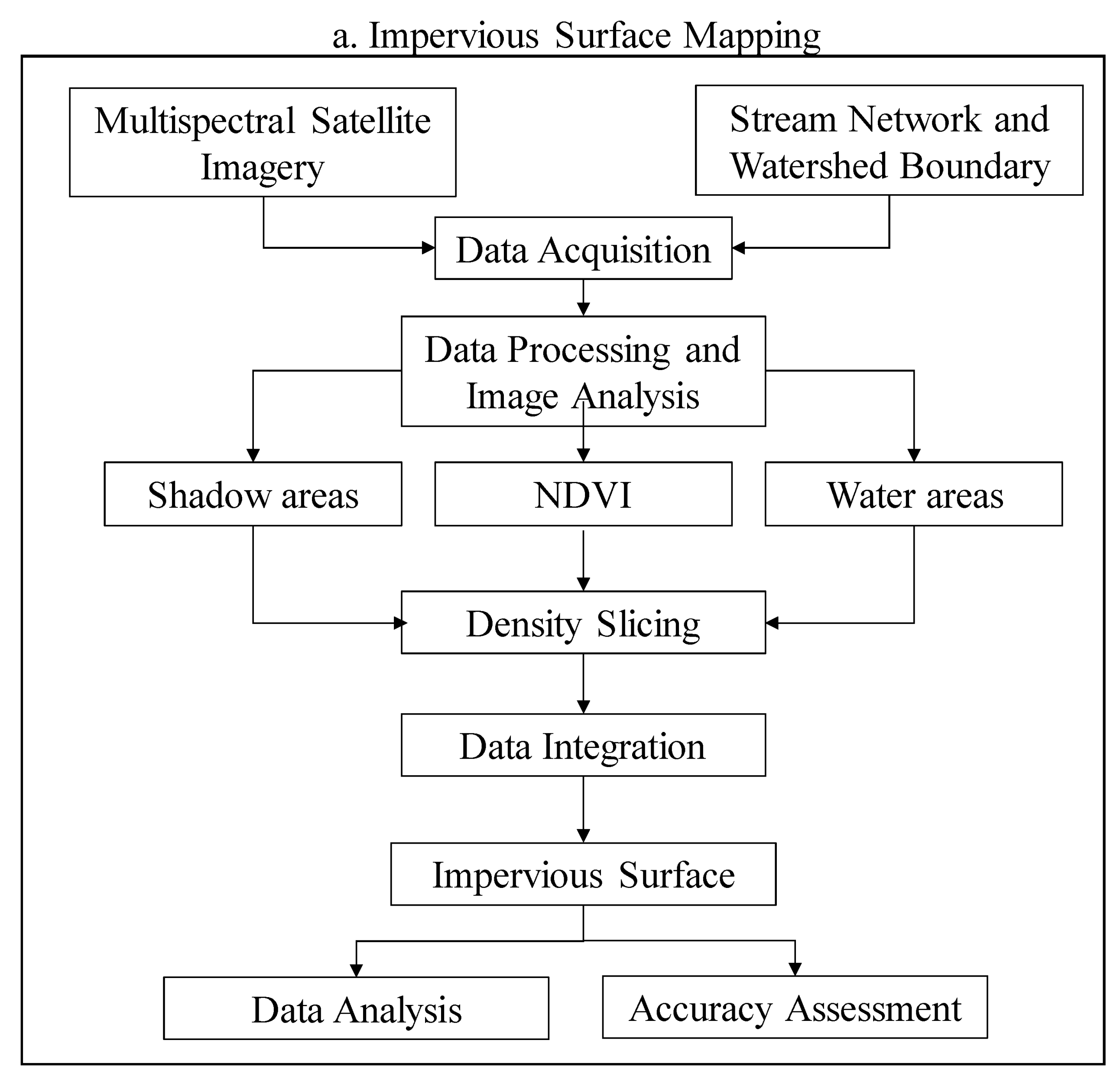


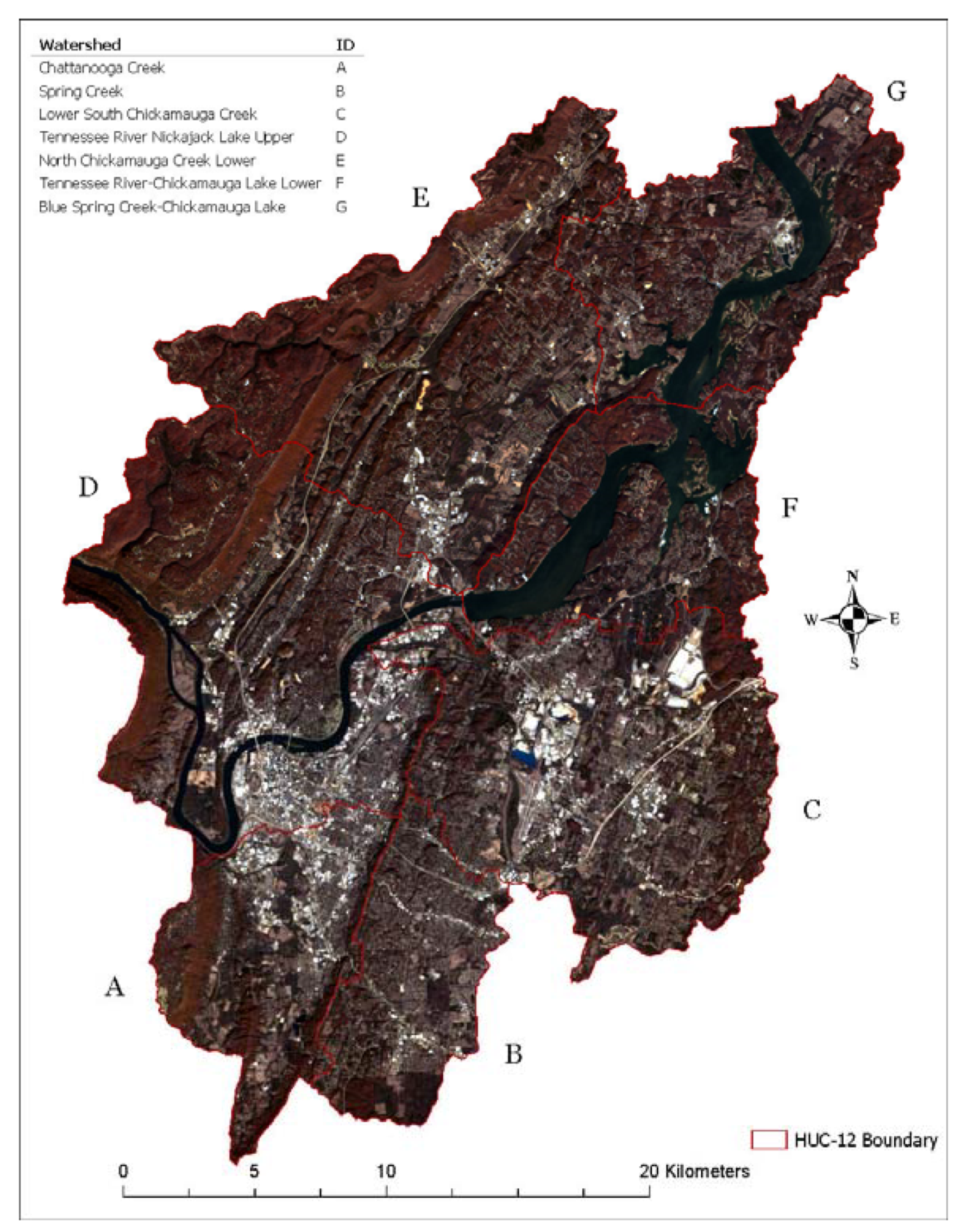


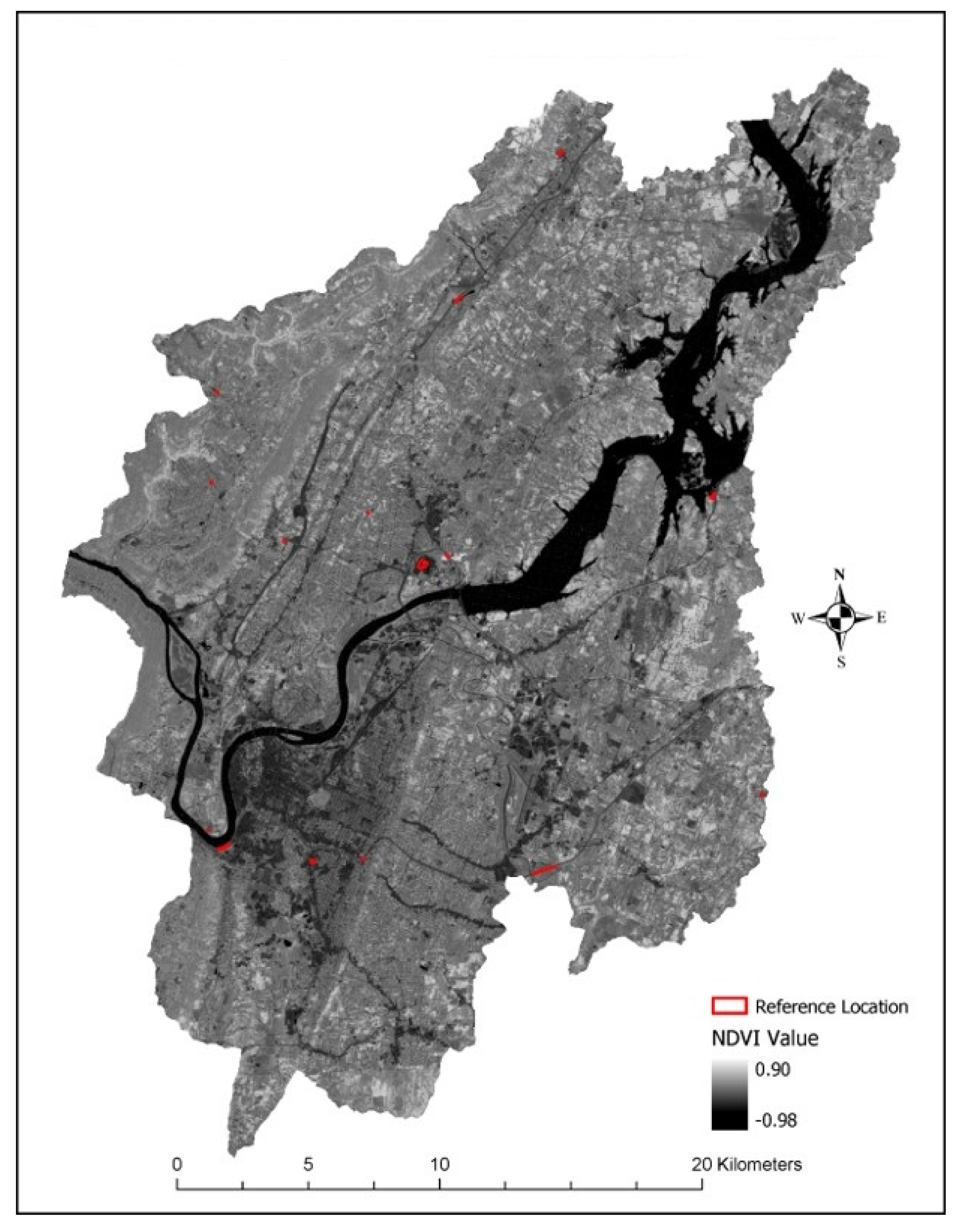
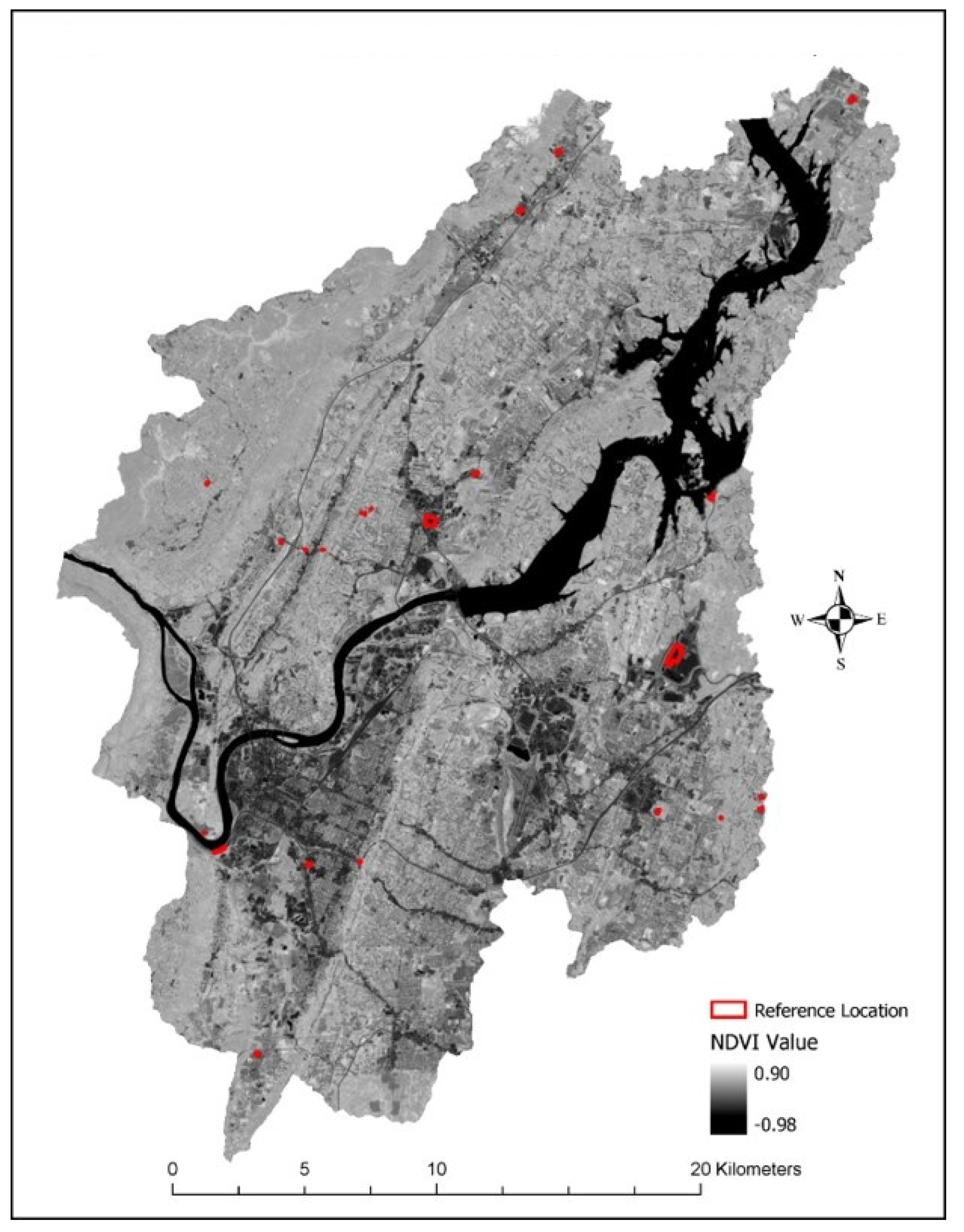

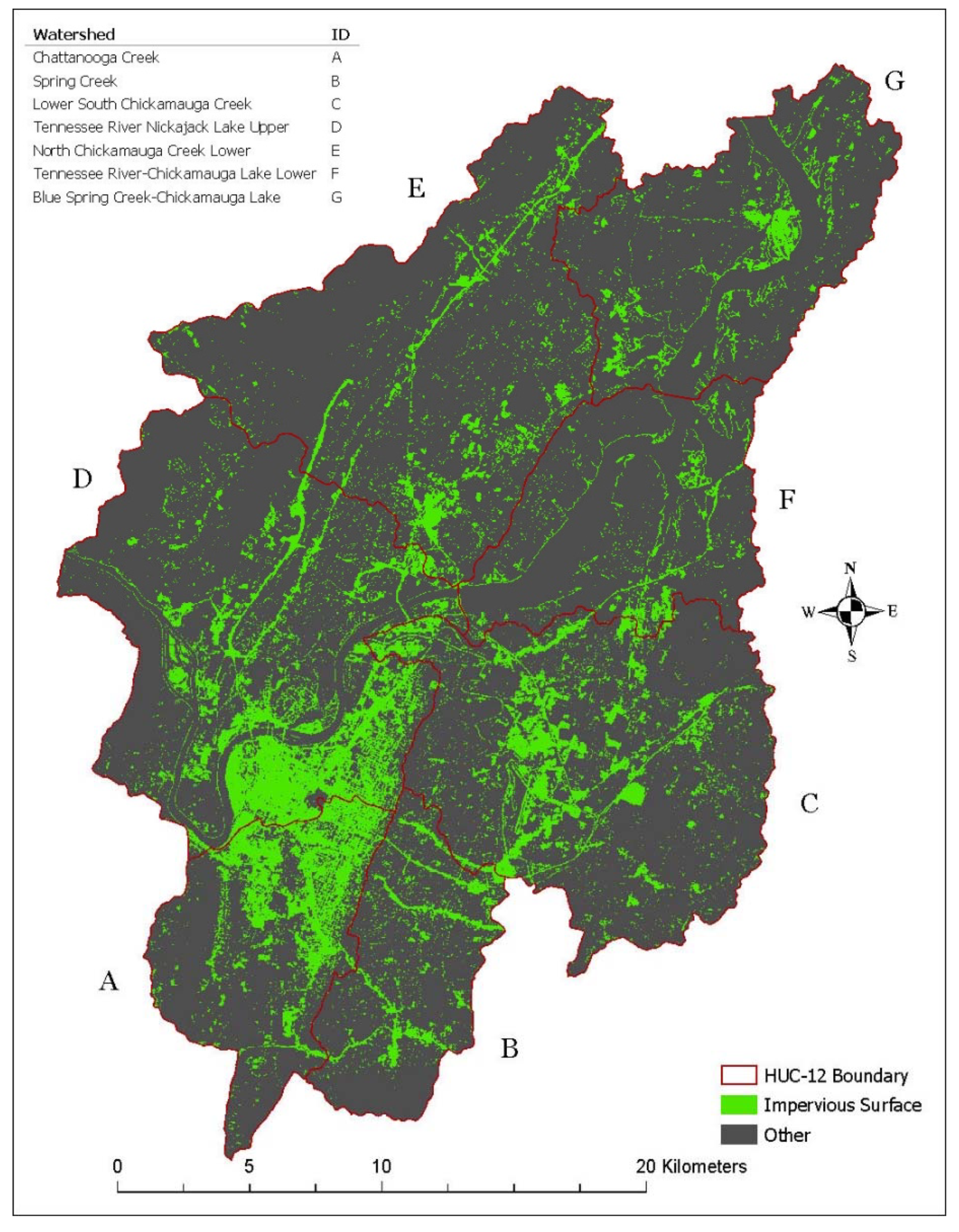
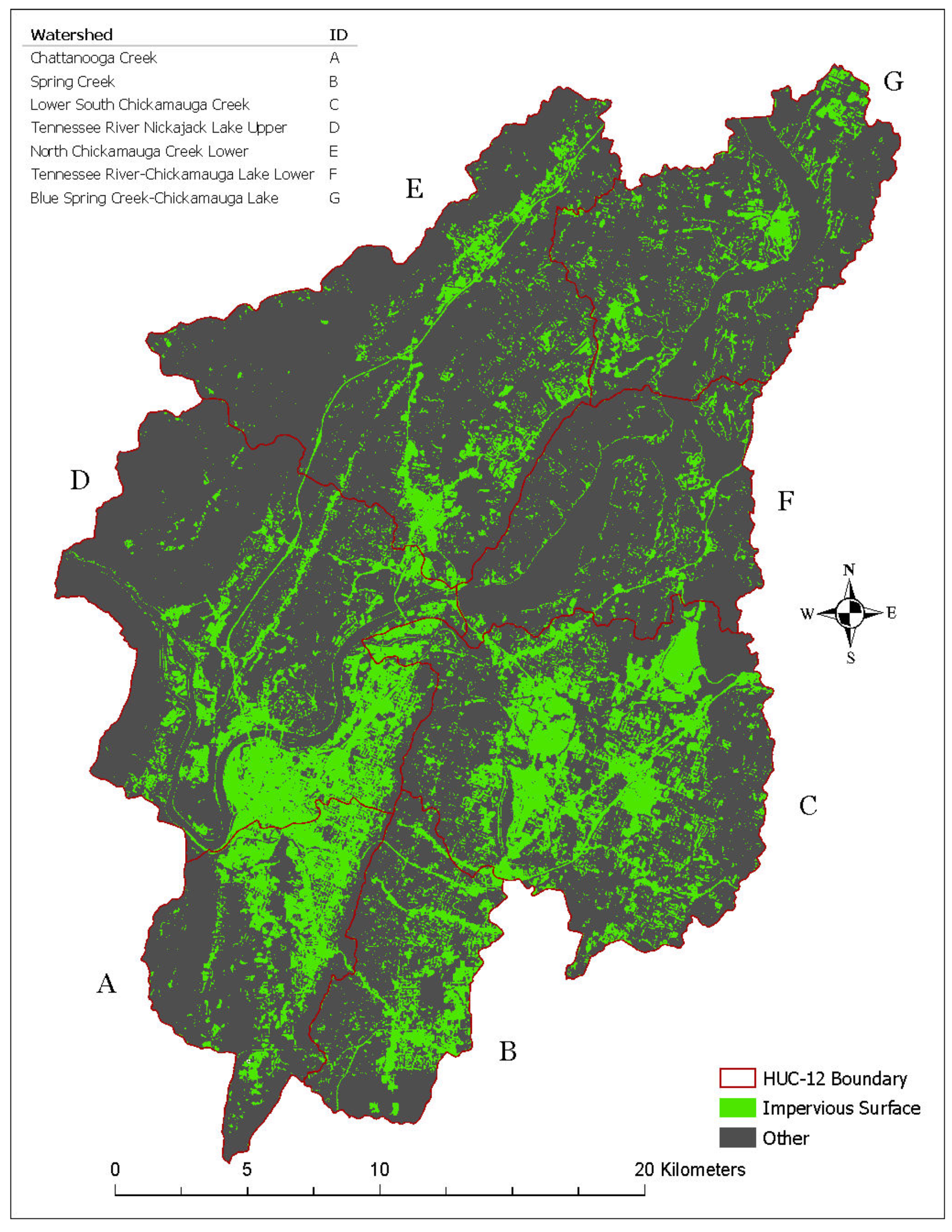


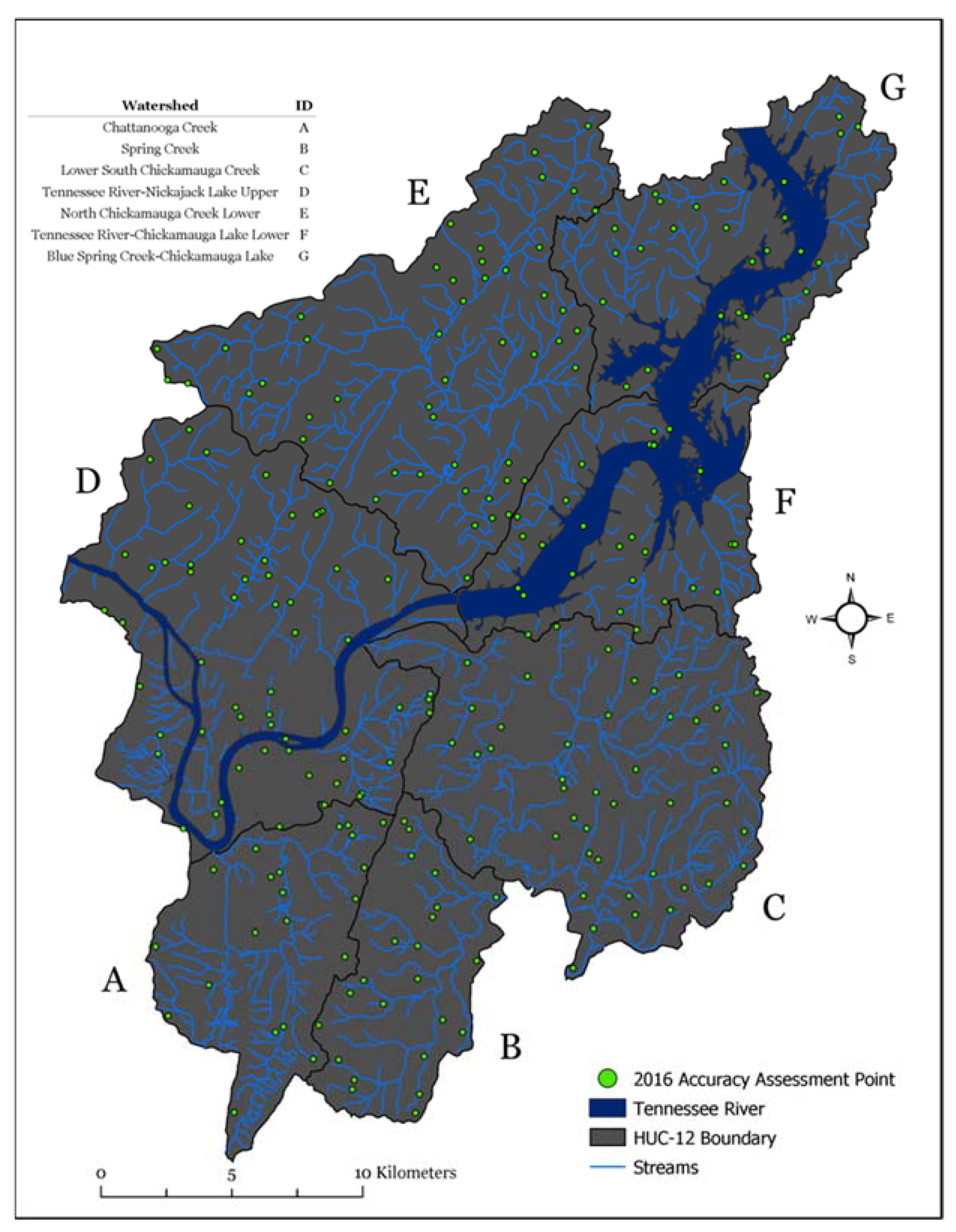

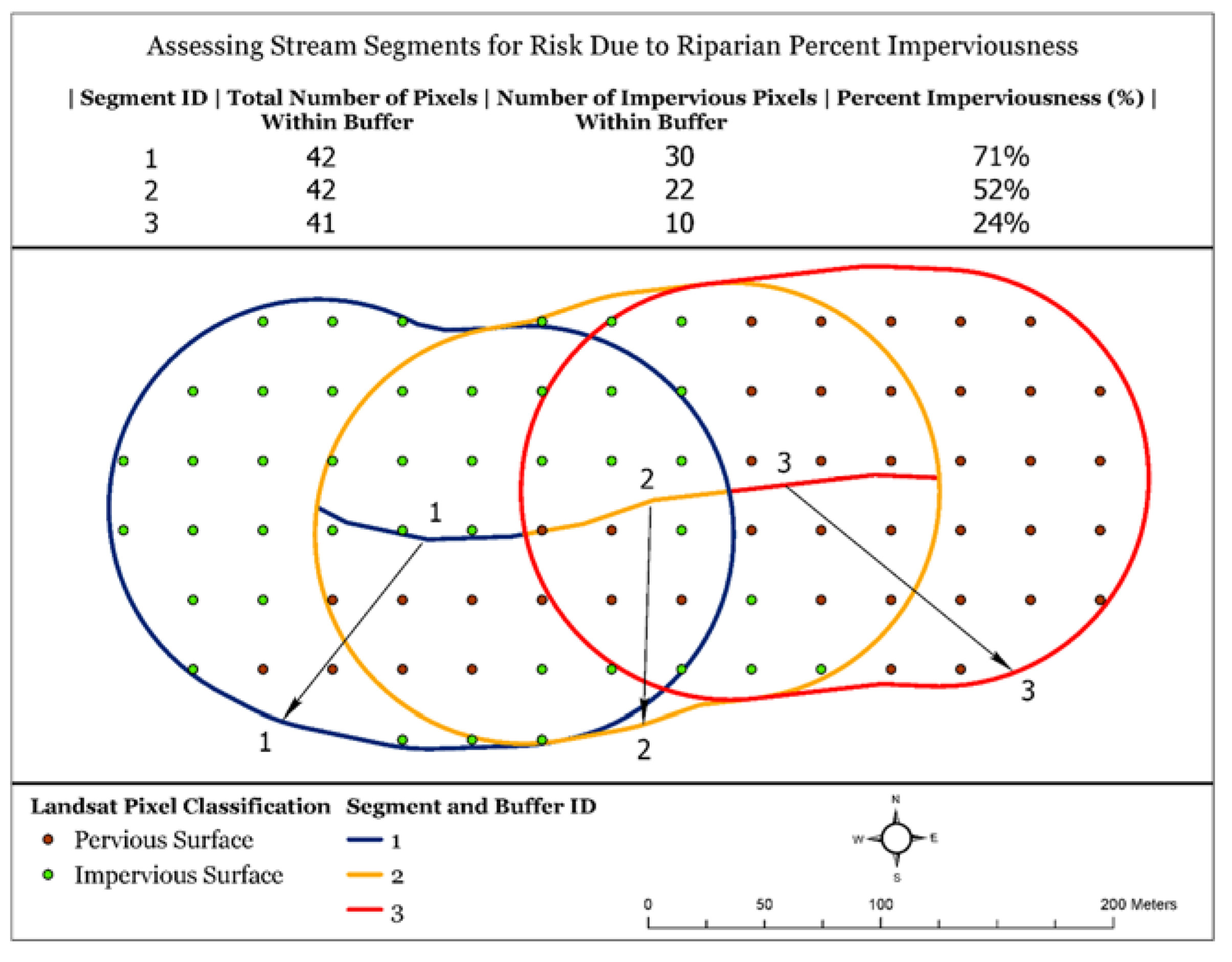

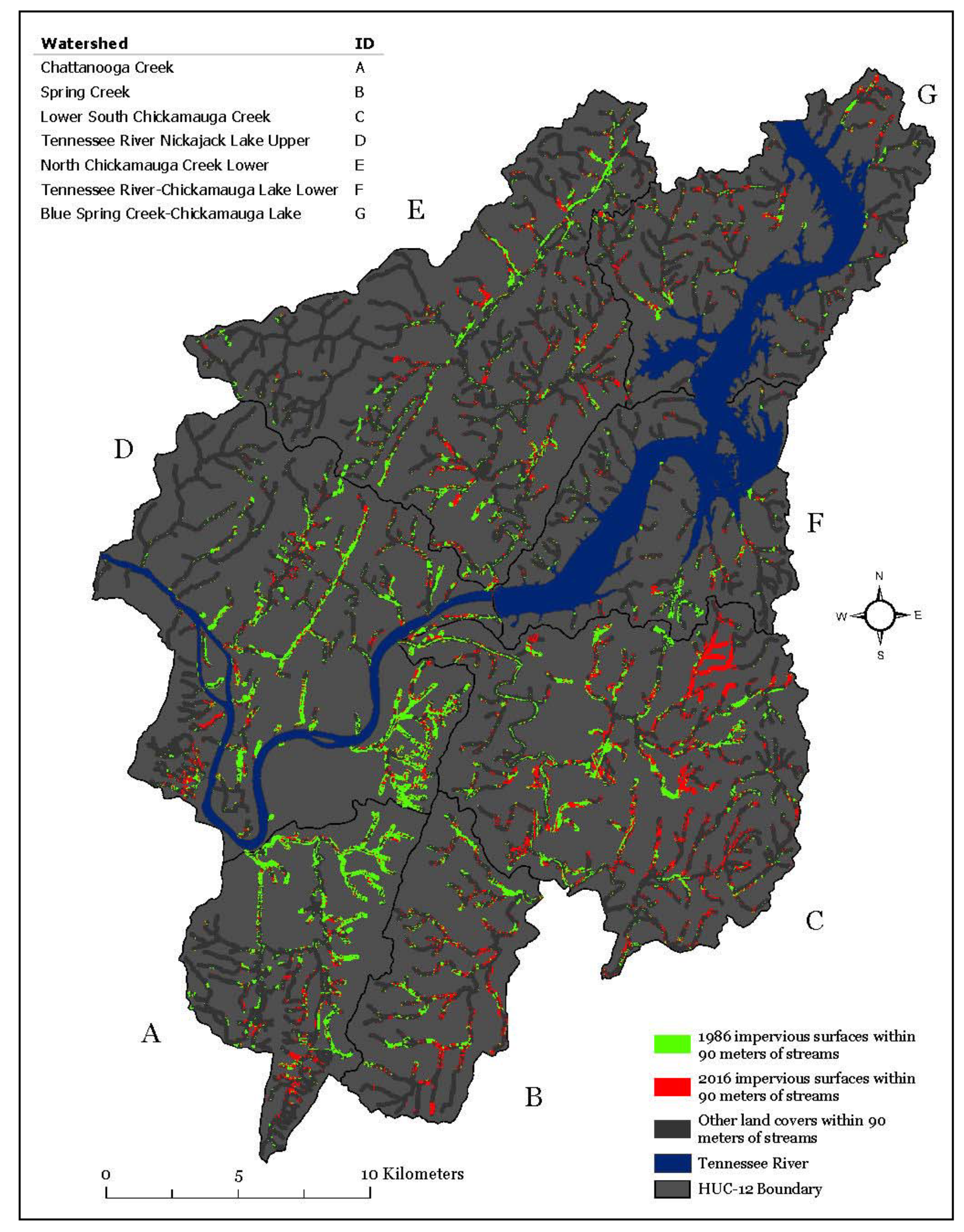
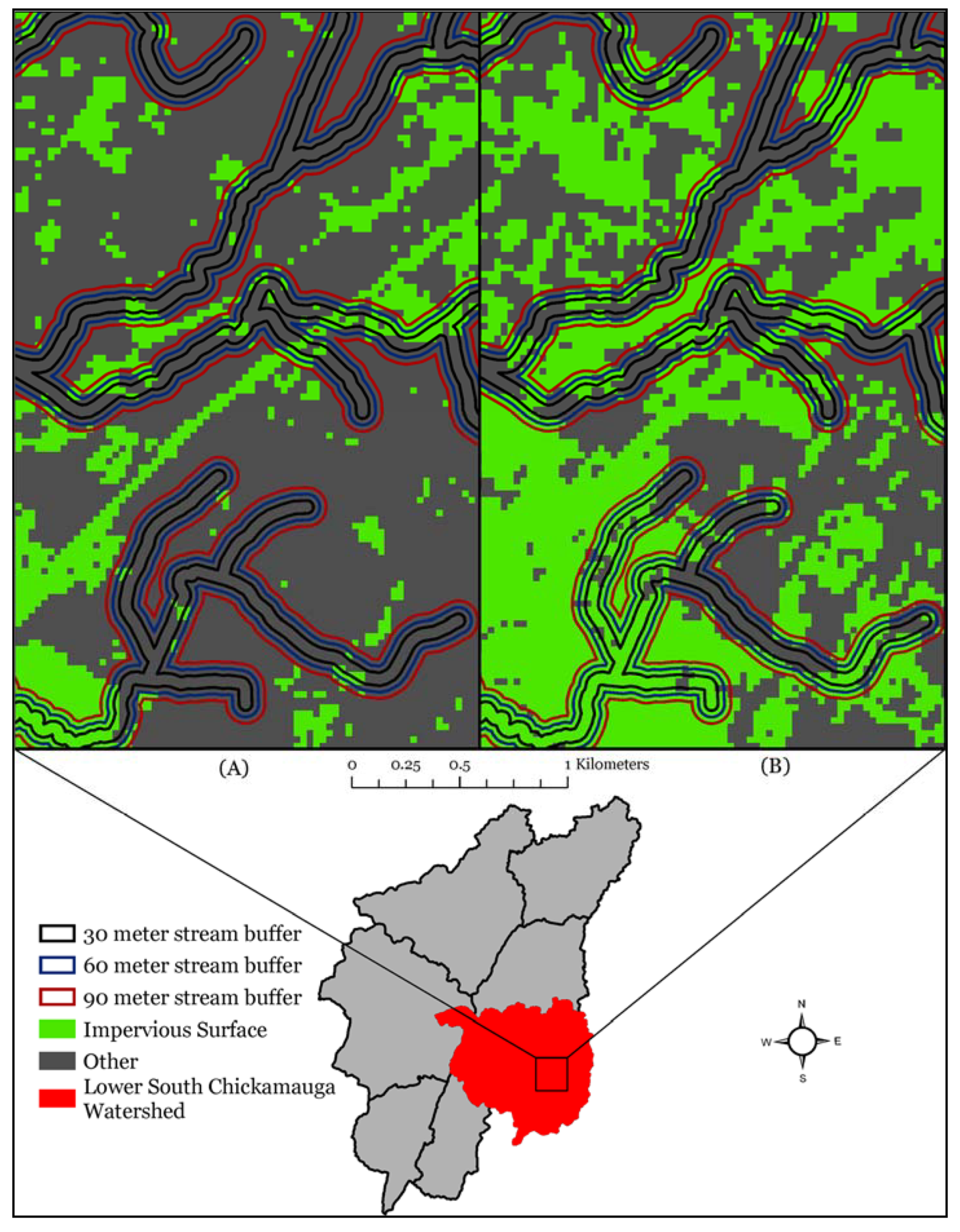

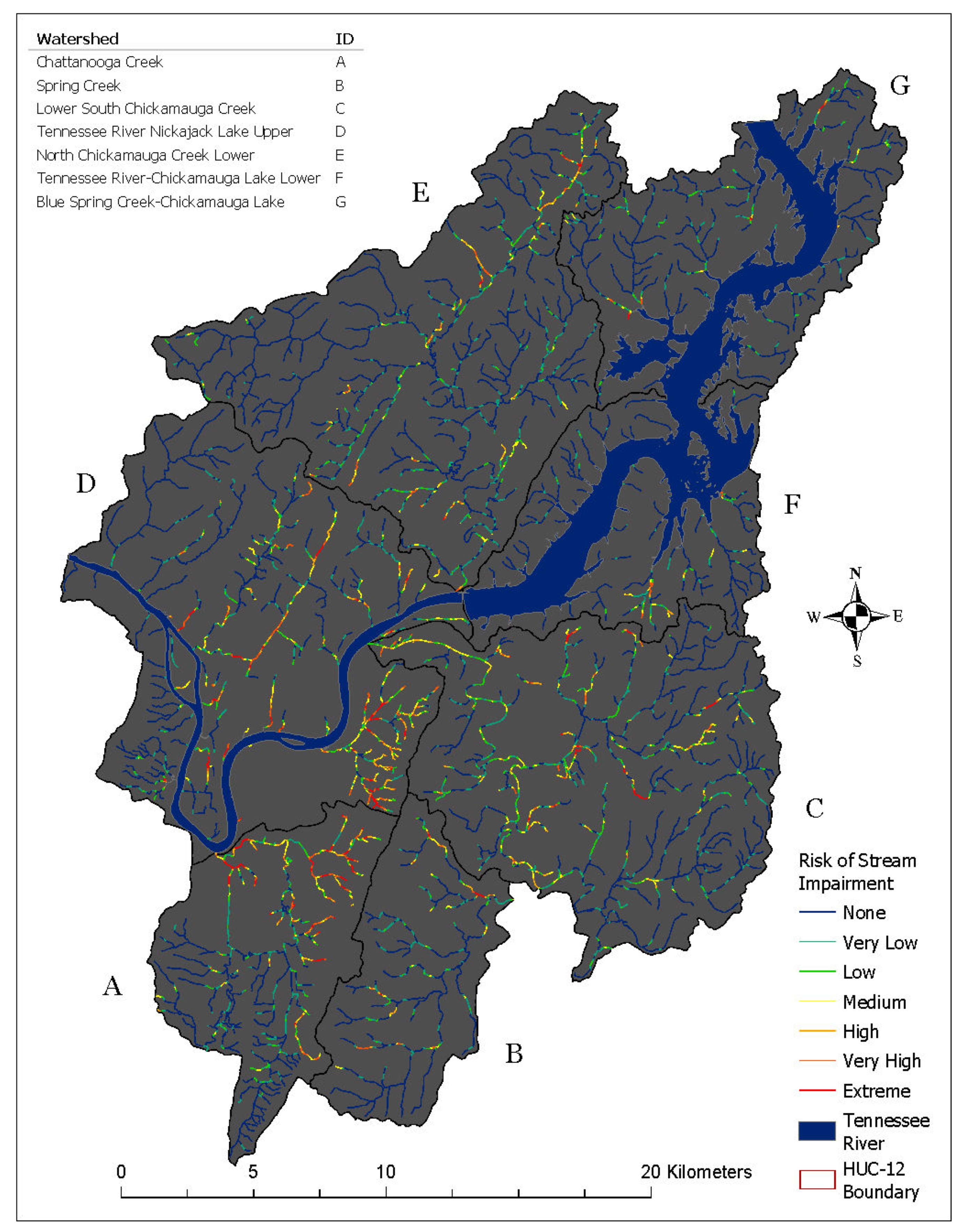
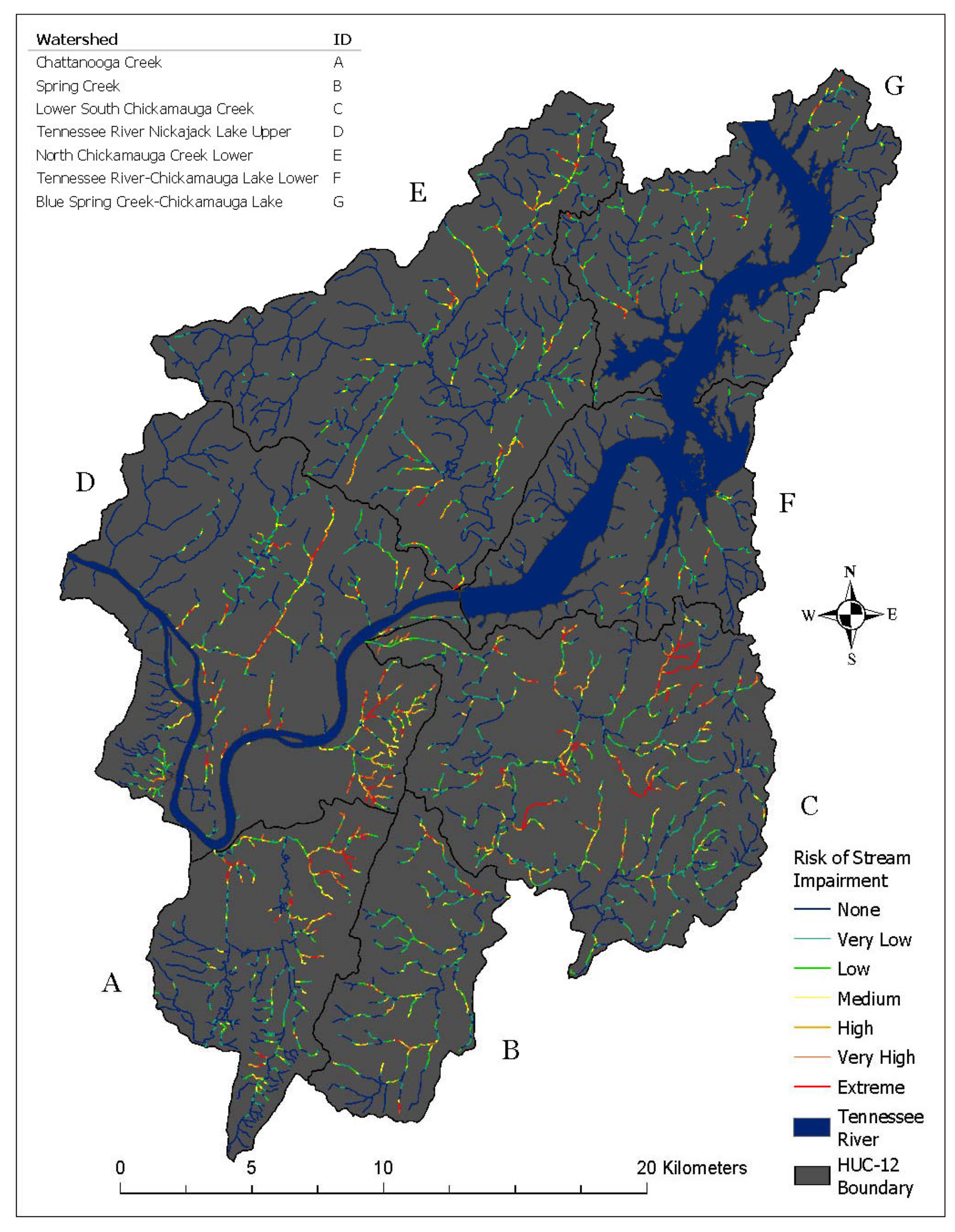

| Water Quality Variable | Land Cover Association | Parameter Concentration | Literature |
|---|---|---|---|
| Total suspended solids (TSS) | General Urban, IS | + | [23,24,25] |
| Turbidity | General Urban | + | [25,26,27] |
| Dissolved solids | Commercial | + | [20,25,28] |
| Dissolved oxygen (DO) | General Urban, IS, Residential, Commercial | - | [18,29,30,31] |
| Heavy metals | General Urban, Residential, Commercial, Industrial | + | [32,33,34] |
| Conductivity | General Urban, IS, Commercial, Residential and Agricultural | + | [29,35,36] |
| Temperature | General Urban, IS | + | [36,37,38] |
| pH | General Urban, IS | + | [36,39,40] |
| Total nitrogen (TN) | Commercial, Residential and Agricultural | + | [26,29,30] |
| Total phosphorus | Residential | + | [28,29,31] |
| Ammonia | General Urban | + | [33,41,42] |
| E. coli | General Urban, IS | + | [36,43,44] |
| Algae (chlorophyll) | Urban General, IS | + | [45,46,47] |
| Fecal coliform | General Urban, IS, Commercial, Residential and Agricultural | + | [24,29,43] |
| Land Cover Type | Year | Data | Threshold Value |
|---|---|---|---|
| Shadows | 1986 | Green Band | (142, 330) |
| 2016 | Green Band | (33, 225) | |
| Vegetation | 1986 | NDVI | (0.255873, 0.790147) |
| 2016 | NDVI | (0.385, 0.902) | |
| Water | 1986 | NIR Band | (38, 350) |
| 2016 | NIR Band | (4, 190) | |
| IS | 1986 | NDVI | (−0.02992, 0.255873) |
| 2016 | NDVI | (−0.09, 0.385) |
| Interval Distance Range from Stream (m) | |||
| 0–30 | 30–60 | 60–90 | |
| Variable | X1 | X2 | X3 |
| Proximity Weight | 3 | 2 | 1 |
| Buffer Distance Range from Stream (m) | |||
| 0–30 | 0–60 | 0–90 | |
| Variable | X | Y | Z |
| Interval Equivalent | X1 | X1 + X2 | X1 + X2 + X3 |
| Classification | Other | Impervious | Total | User’s Accuracy | Kappa (k) |
|---|---|---|---|---|---|
| Other | 198 | 12 | 210 | 94.3% | |
| Impervious | 13 | 27 | 40 | 67.5%. | |
| Total | 211 | 39 | 250 | ||
| Producer’s Accuracy | 93.8% | 69.2% | 90.0% | ||
| Kappa (k) | 0.624 |
| Classification | Other | Impervious | Total | User’s Accuracy | Kappa (k) |
|---|---|---|---|---|---|
| Other | 178 | 16 | 194 | 91.7% | |
| Impervious | 22 | 34 | 56 | 60.7% | |
| Total | 200 | 50 | 250 | ||
| Producer’s Accuracy | 89% | 68% | 84.8% | ||
| Kappa (k) | 0.545 |
| Impervious Surface (IS) Area in Square Kilometers and Percentage | |||
|---|---|---|---|
| HUC Watershed | 1986 | 2016 | Percent Increase |
| Chattanooga Creek | 20.12 | 20.11 | −0.1% |
| Spring Creek | 7.42 | 14.24 | 91.9% |
| Tennessee River - Nickajack Lake Upper | 37.93 | 40.31 | 6.3% |
| Tennessee River Chickamauga Lake Lower | 9.26 | 13.91 | 50.2% |
| Lower South Chickamauga Creek | 24.23 | 48.48 | 100.8% |
| North Chickamauga Creek lower | 14.63 | 20.85 | 42.5% |
| Blue Spring Creek - Chickamauga Lake | 6.73 | 7.54 | 12.0% |
| Impervious Surface (IS) Area in Square Kilometers within Stream Riparian Zones | |||||||||
|---|---|---|---|---|---|---|---|---|---|
| Zones | 30 m | 60 m | 90 m | ||||||
| Watershed ID | 1986 | 2016 | % Change | 1986 | 2016 | % Change | 1986 | 2016 | % Change |
| A | 1.49 | 1.32 | −11.5 | 3.18 | 3.07 | −3.5 | 4.89 | 4.91 | 0.4 |
| B | 0.47 | 0.89 | 89.4 | 1.00 | 1.90 | 90.0 | 1.57 | 2.98 | 89.8 |
| C | 2.59 | 2.74 | 5.7 | 5.42 | 5.72 | 5.5 | 8.07 | 8.84 | 9.5 |
| D | 0.40 | 0.70 | 75 | 0.77 | 1.41 | 83.1 | 1.13 | 2.14 | 89.4 |
| E | 2.16 | 3.52 | 63 | 3.99 | 7.28 | 82.4 | 5.71 | 11.34 | 98.6 |
| F | 1.54 | 1.52 | −1.3 | 2.99 | 3.39 | 13.4 | 4.42 | 5.46 | 23.5 |
| G | 0.27 | 0.28 | 3.7 | 0.55 | 0.60 | 9.1 | 0.91 | 1.00 | 9.9 |
| Interval | Year | Mean | Standard Deviation | Quartile | ||||
|---|---|---|---|---|---|---|---|---|
| Min. | 25% | 50% | 75% | Max. | ||||
| 0 m–30 m | ||||||||
| 1986 | 15.2% | 27.4% | 0.0% | 0.0% | 0.0% | 20.0% | 100% | |
| 2016 | 17.9% | 29.8% | 0.0% | 0.0% | 0.0% | 25.0% | 100% | |
| 30 m–60 m | ||||||||
| 1986 | 15.2% | 24.1% | 0.0% | 0.0% | 0.0% | 21.4% | 100% | |
| 2016 | 20.1% | 27.7% | 0.0% | 0.0% | 7.1% | 33.3% | 100% | |
| 60 m–90 m | ||||||||
| 1986 | 15.5% | 23.0% | 0.0% | 0.0% | 5.2% | 22.2% | 100% | |
| 2016 | 21.6% | 27.0% | 0.0% | 0.0% | 10.5% | 35.7% | 100% | |
| Risk of Impairment | Model Score |
|---|---|
| None | 0 < 1 |
| Very Low | ≥1 < 2 |
| Low | ≥2 < 3 |
| Medium | ≥3 < 4 |
| High | ≥4 < 5 |
| Very High | ≥5 < 6 |
| Extreme | 6 |
| Quartile | |||||||
|---|---|---|---|---|---|---|---|
| Year | Mean | Standard Deviation | Min. | 25% | 50% | 75% | Max. |
| 1986 | 0.92 | 1.45 | 0 | 0 | 0.15 | 1.22 | 6 |
| 2016 | 1.06 | 1.47 | 0 | 0 | 0.33 | 1.57 | 6 |
| Risk of Impairment | 1986 (km) | 2016 (km) | Change (km) |
|---|---|---|---|
| None | 8155 (634) | 7168 (550) | −987 (84) |
| Very Low | 1883 (148) | 2108 (169) | +225 (21) |
| Low | 1012 (77) | 1278 (100) | +266 (23) |
| Medium | 737 (58) | 812 (63) | +75 (5) |
| High | 506 (36) | 593 (45) | +87 (9) |
| Very High | 374 (27) | 505 (38) | +131 (11) |
| Extreme | 243 (17) | 446 (32) | +203 (15) |
© 2020 by the authors. Licensee MDPI, Basel, Switzerland. This article is an open access article distributed under the terms and conditions of the Creative Commons Attribution (CC BY) license (http://creativecommons.org/licenses/by/4.0/).
Share and Cite
Hall, J.; Hossain, A.K.M.A. Mapping Urbanization and Evaluating Its Possible Impacts on Stream Water Quality in Chattanooga, Tennessee, Using GIS and Remote Sensing. Sustainability 2020, 12, 1980. https://doi.org/10.3390/su12051980
Hall J, Hossain AKMA. Mapping Urbanization and Evaluating Its Possible Impacts on Stream Water Quality in Chattanooga, Tennessee, Using GIS and Remote Sensing. Sustainability. 2020; 12(5):1980. https://doi.org/10.3390/su12051980
Chicago/Turabian StyleHall, Jonah, and A. K. M. Azad Hossain. 2020. "Mapping Urbanization and Evaluating Its Possible Impacts on Stream Water Quality in Chattanooga, Tennessee, Using GIS and Remote Sensing" Sustainability 12, no. 5: 1980. https://doi.org/10.3390/su12051980
APA StyleHall, J., & Hossain, A. K. M. A. (2020). Mapping Urbanization and Evaluating Its Possible Impacts on Stream Water Quality in Chattanooga, Tennessee, Using GIS and Remote Sensing. Sustainability, 12(5), 1980. https://doi.org/10.3390/su12051980




